WBBSE 9th Class Social Science Solutions History Chapter 3 Europe in the 19th century: Conflict of Monarchical and Nationalist Ideas
WBBSE 9th Class Social Science Solutions History Chapter 3 Europe in the 19th century: Conflict of Monarchical and Nationalist Ideas
WBBSE 9th Class Social Science Solutions History Chapter 3 Europe in the 19th century: Conflict of Monarchical and Nationalist Ideas
West Bengal Board 9th History Solutions
WBBSE 9th Class History Solutions
Salient points – At a glance
1. The defeat of Napoleon, the French emperor in the Battle of Waterloo (1815) meant the overthrow of the vast empire he had built. It was necessary to decide the fate of the territories which Napoleon had conquered. So the leaders who played the most important part in defeating Napoleon met at Vienna (1815) to draw up a new map of Europe.
2. Metternich was the most powerful personality with the greatest influence on European politics in the post-Napoleonic period. The period between the Vienna Settlement and the Revolution of 1848 came to be known as the ‘Age of Metternich’. Metternich devised a system that aimed at maintaining peace and security in Europe as well as preventing the spread of progressive idea.
3. The spirit propagated by the French Revolution created problems. The concept of nationalism and nation state was championed by the people. Thus a conflict between monarchical and nationalist forces arose. The conflict ultimately ended in the triumph of liberalism over reaction.
4. The Vienna Settlement (1815) restored the old ruling families to their respective thrones. Moreover, it stood for restoration of pre-revolution conditions but the Vienna Congress completely ignored the will of the common people.
5. The people now demanded the right to participate in the government. Thus there was a conflict between monarchical and nationalist ideals. In monarchical states like France, Austria and other countries, people launched movements for democratic rights. Suppressed nationalities like the Germans, Italians, Hungarians started movements for the establishment of nation states. Italy and Germany emerged as nation states.
6. The hopes and aspirations of the Christian nationalities in the Balkan region gave rise to complex problems. In 1854, the Crimean War broke out. The Treaty of Paris brought an end to it in 1856 but it failed to resolve the ‘Eastern Question’.
7. In Russia also revolutionary forces were increasingly active. Czar Alexander II passed the Emancipation Statute which generated new socio-political and intellectual forcesthis clashed with the existing political framework of Czarist absolution.
8. The nationalistic and democratic ideals of the French Revolution influenced the Greeks and they also started their own struggle for freedom. The Greek struggle for independence began with the activities of the secret societies. The Greeks ultimately severed themselves from Turkish domination and came to be recognised as an independent state.
TOPIC – A
Conception of Nation State, Vienna Settlement and Metternich System
Explanatory Answer (EA) Type Questions
Answer in 12 to 15 sentences
1 “The real purpose of the Congress of Vienna was to divide among the conquerors the spoils taken from the vanquished.”-Discuss
Ans. According to the Principle of Compensation of the Vienna Congress (1815), the old ruling families were brought back to their respective thrones. The Congress generally followed the rule of restoring to every king, prince or duke the territory which had been his before 1789. Care was, however, taken so that each of the big four powersAustria, Russia, Prussia and England got additional territories.
[1] England: England got Malta, lonian Island in eastern Mediterranean, Heligoland, Trinidad and Mauritius, Ceylon and the Cape of Good Hope.
[2] Austria: Austria was compensated for the loss of Belgium by getting the Italian possession of Lombardy and Venetia and she also received Tyrol, Salsbury and Illyria.
[3] Prussia: Prussia got the northern part of Saxony, Posen, Thorn, Dangeig, Rhine area and West Pomerania.
[4] Russia: Russia got one-fourth part of Poland and also got compensation in Finland and in the Turkish province Bassarabia.
Thus it could be said that “The real purpose of the Congress was to divide among the conquerors the spoils taken from the vanquished.”
2. Discuss the basic principles of the Vienna Congress.
Ans. After the downfall of Napoleon, a conference of the heads of the European countries was held at Vienna, the capital of Austria in 1815. The basic principles of the Vienna Congress were-[1] The Principle of Legitimacy, [2] The Principle of Balance of Power, and [3] The Principle of Compensation.
The Principle of Legitimacy: According to this principle, it was decided that those rulers who had been driven from their states and had bee deprived of their thrones should be reinstated. In other words, the diplomats of the Vienna Congress did not recognise any political change that had occured in Europe after 1789. They were determined to bring back the Europe that existed before the French Revolution. losses because of Napoleon. Since the allies had
The Principle of Balance of Power: The diplomats of the Vienna Congress decided that the power of the different countries should be balanced so that no country could threaten another. It indicated balancing the neighbouring kingdom of France with the latter in such a way that France would not be able to disturb the European order of 1815 in the coming years.
The Principle of Compensation: According to this principle, it was decided that those states which had helped the allies against Napoleon were to be rewarded, but those which had supported Napoleon were to be punished. Moreover, it was also decided that those kingdoms should be compensated that had either been destroyed or had suffered losses because of Napoleon. Since the allies had taken an active part in the downfall of Napoleon, it was also decided to compensate them by giving them some new territories.
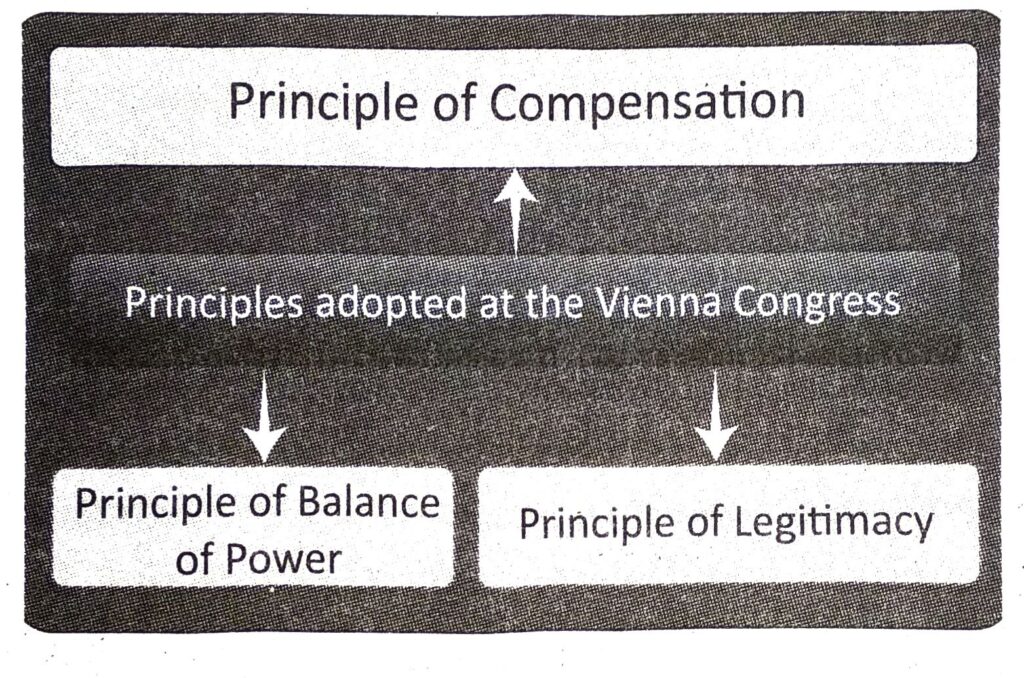
Know More
The Vienna Congress held in 1815 was the first ever international conference in the history of Europe and of the world.
3. Criticise the work of the Vienna Congress (1815). Se the
Ans. The Vienna Congress (1815) was convened with declaration of high morals and principles. It was expected that the settlement of the Vienna Congress would prove valuable for the establishment of peace based upon a just division of power. But it has been remarked that it was a symbol of reaction, conservatism and selfishness of big powers. It was criticised on the following grounds: [1] The principles adopted at the Vienna Congress were overlooked by the diplomats. The Principle of Legitimacy was not applied in many states like Naples, Saxony and Genoa. Each representative was eager to grab as many provinces as he could. [2] The representatives of the Vienna Congress did not represent the common people. The Congress ignored the feelings of the common people and did not respect the rights of the people. [3] The Congress ignored the feelings of nationality. They divided many states and annexed them to one another twit without keeping in their minds the idea of nationality. The rulers rearranged Europe according to their own desires, disposing of it as if it was their own personal property. [4] The Congress ignored the feelings of the revolution. The feelings of liberty, equality and fraternity were ignored while undertaking the great work of the reconstruction of Europe.
Know More
The Vienna Congress laid the foundation of internationalism. The bases of the League of Nations and the United Nations Organisation were built United Nat up here.
4. What arrangements were made in Europe according to the Principle of Compensation?
Ans. According to the Principle of Compensation of the Vienna Congress, it was decided that those states which had helped the Allies against Napoleon, were to be rewarded. But those states which had supported Napoleon were to be punished. [1] As England played the most important role in bringing about the defeat of Napoleon, England received the lion’s share of compensation. England got Malta, lonian Islands in eastern Mediterranean, Heligoland, Ceylon, Trinidad, Mauritius and the Cape Colony in Africa. [2] Russia got most of the Polish territory, Finland, the Turkish province Bessarabia, and a major part of the Grand Duchy of Warsaw. [3] Prussia got Swedish Pomerania, some Polish territory, about two-fifth of Saxony and large districts of the Rhine. [4] Austria was given Venetia and Lombardy in Italy as compensation for the loss of Belgium. It got Tyros from Bavaria and Illyrian provinces along the Eastern coast of the Adriatic. [5] It was also decided that those states which had supported Napoleon were to be punished. Poland was punished. This big country was divided into three parts and given to Russia, Prussia and Austria respectively. [6] As the king of Denmark had helped Napoleon against the Allies, Denmark was punished. Norway was snatched away from it and was given to Sweden.
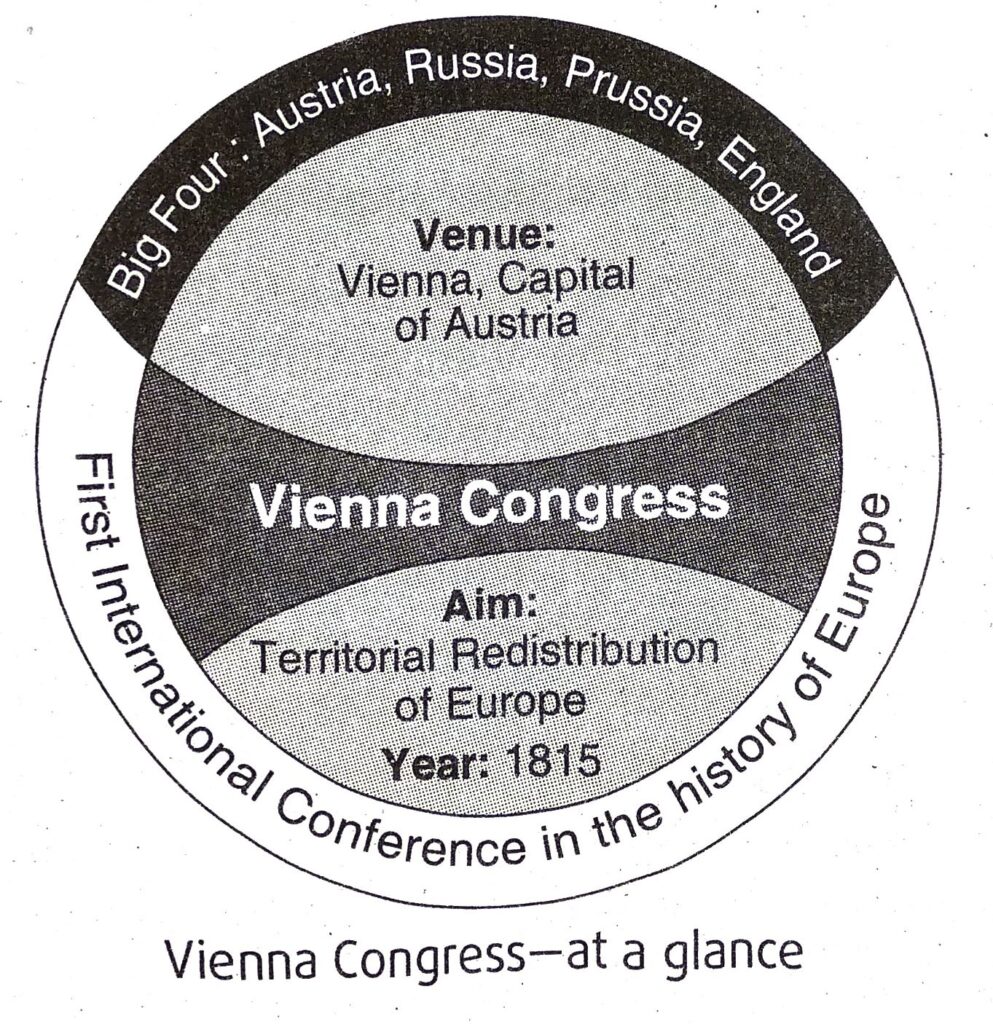
5. Why is the period between 1815-1848 known as the Age of Metternich ?
Ans. The period between 1815-1848 is called the ‘Age of Metternich’ in European politics. In the post-Napoleon period he was the most powerful personality in moulding the shape of European politics.
[1] As a Conservative Politician: Metternich was a conservative politician. He was not interested in bringing about reforms and Porfavoured an authoritarian style of functioning. He was the symbol of those forces eager to preserve the status quo. He was eager to remove the sparks of revolution and liberalism wherever he could detect them. He was apprehensive that a liberal democratic style of functioning could bring back in Europe revolutionary fervours. Therefore, he favoured a reactionary system of governance under the leadership of Austria.
[2] Domestic Policy: Metternich laid down certain domestic measures which were totally opposed to nationalist thinking such as press censorship, setting up a network of police and spies. Strict control was placed on educational institutions to prevent it from becoming breeding grounds of evolutionary ideas, suppressing nationalist and liberal ideas.
[3] Foreign Policy: To maintain peace Metternich wanted to maintain status quo. He crushed liberalism in Italy, Germany and Spain. He also prevented the Russians from helping the Greeks. He kept an eye on the Russians to see that they did not extend their influence on the Greeks.
Metternich’s repressive system kept peace and order in Europe for three long decades and saved the Austrian empire.
Analytical Answer (AA) Type Questions
Answer in 7 to 8 sentences
1. Why was there a conflict between monar chical and nationalist ideals after 1815 ?
Ans. The defeat of Napoleon, the French emperor, in the Battle of Waterloo (1815) meant the overthrow of the vast empire he had built. It was necessary to decide the fate of the territories which Napoleon had conquered. So the leaders who played the most important part in defeating Napoleon met at Vienna (1815) which completely ignored the will of the people. The people did not forget the lessons of the French Revolution and demanded that the government should be formed so as to derive its right from the will of the governed. Moreover, in some countries like Italy and Germany, people who spoke the same language and were members of the same nationality were compelled to live in separate states into which these countries were artificially divided. Thus the aspiration of the people were twofold: [1] democratic or liberal which aimed at winning for the people the right to participate in the government and [2] nationalist which was the outcome of the people’s desire to form themselves into a unified state. As a result there was a conflict between monarchical and nationalist ideals after 1815.
2 “The Vienna Treaty was a reasonable and statesmanlike settlement.”-Write in support of the Vienna settlement. Or, On what ways was the Vienna Congress successful?
Ans. It is generally said that “The Congress of Vienna made mistakes both of omission and commission”. Inspite of the mistakes, this conference proved very useful in the following ways: [1] It was the first occasion when the representatives of almost all the countries of Europe gathered to solve the international problems. [2] It saved Europe from the continental wars for a period of about forty years. No war was fought for about 40 years i.e. 1815-1856. [3] It abolished the inhuman system of slavery. The diplomats passed a resolution and made an appeal to abolish slavery.
Thus it may be concluded that although the Vienna Congress committed many mistakes yet it is true that it was “an honest attempt to prevent future war and the best that could have been derived in 1815.”
Representatives Who Took part in the Vienna Congress
| Representatives | Countries to which they belonged |
| Metternich | Austria |
| Czar Alexander I | Russia |
| Hardenberg | Prussia |
| Castlereagh | Great Britain |
| Talleyrand | France |
| Francis I | Austria |
| Frederick William III | Prussia |
3. What decisions were taken regarding France at the Vienna Congress (1815)?
Ans. The following decisions were taken regarding France at the Vienna Congress (1815) [1] The Bourbon dynasty was restored in France according to the Principle of Legitimacy. Louis XVIII of the Bourbon dynasty was placed on the throne of France. [2] France was asked to pay the war expenses amounting to seventy million francs. [3] 150,000 soldiers of the allied countries would stay in France till the full payment of the war expenses had been made. [4] France was to go back to her boundaries as in 1789 and sacrifice all lands conquered by Napoleon. [5] States like Holland, Piedmont, Prussia, Austria bordering France were strengthened so that France would not be able to disturb the European order in future years. [6] France was required to restore all the historical artefacts and works of art which Napoleon had brought to France from different parts of Europe.
4. Which period is known as the ‘Age of Conferences’? What were the conferences held during this period?
Ans. The period between 1815-1825 is called the ‘Age of Conferences’ in the history of Europe.
Five Conferences were held during this period. These were- —[1] Aix-la-Chapelle (1818), [2] Troppau. (1820), [3] Laibach (1822), [4] Verona (1822), [5] St. Petersburg (1825).
5. What were the main objectives of the Quadruple Alliance?
Ans. The Allied powers-Great Britain, Russia, Austria and Prussia-signed a document in 1815 which was called the ‘Quadruple Alliance’. Their main objectives were: [1] To unitedly oppose the attempts of Napoleon and his descendants to grab the throne of France. [2] To take united action, if necessary, in order to prevent the growth of the spirit of revolution in the European countries. [3] To strictly implement the decisions of the Congress of Vienna in all countries of Europe. [4] To make united attempts to maintain peace and order in Europe.
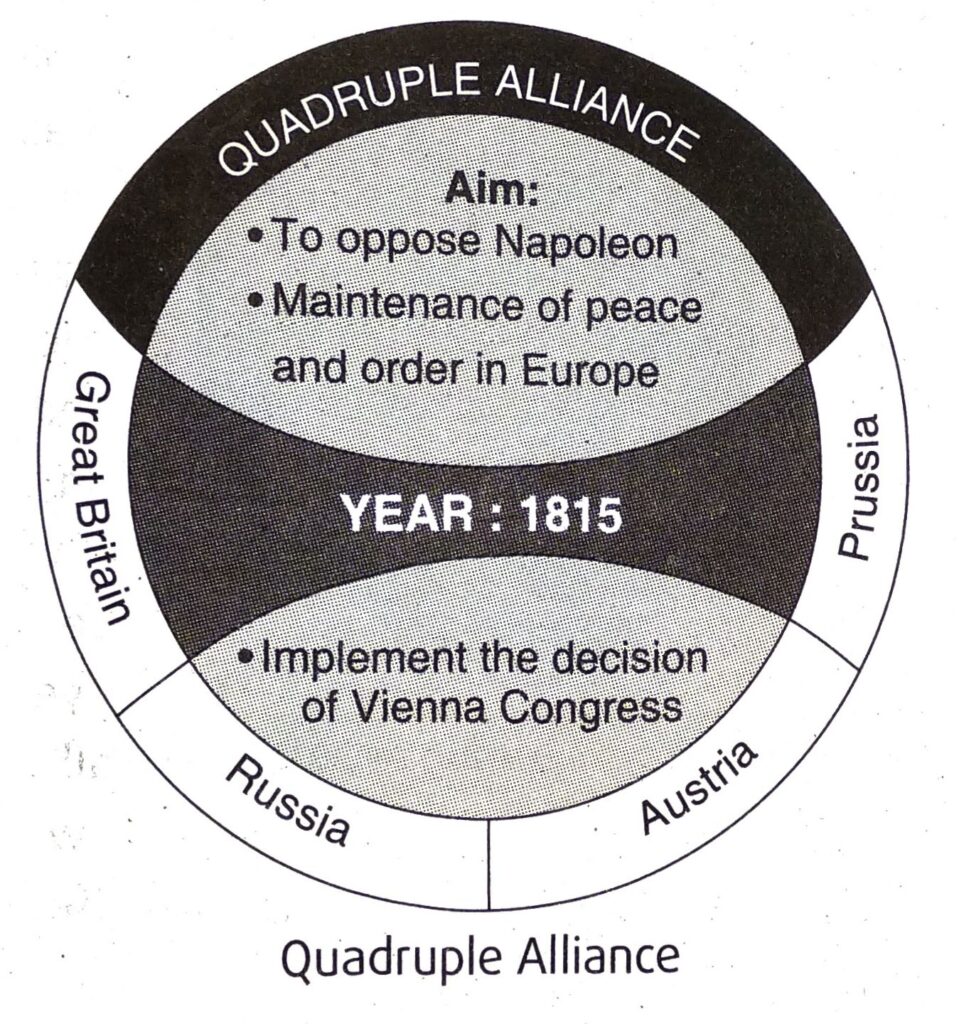
6. What was the Concert of Europe? What were its objectives?
Ans. The Concert of Europe was the system to designate an agreement by the major European powers to act together on European questions of common interest. Metternich wanted to make the Concert of Europe between Great Britain, Russia, Prussia and Austria which was signed in 1815 into an instrument for preventing any future revolution in Europe .
Objectives: The main objectives were[1] Preservation of peace all over Europe by suppressing any move or development that might cause wars. [2] Promotion of friendly relations among the four big powers-Great Britain, Russia, Prussia and Austria. [3] Preservation of political stability in Europe. [4] To suppress nationalist and democratic forces. [5] To prevent the rise of any powerful personality like Napoleon.
7. What were the merits and demerits of Metternich system?
Ans. Metternich was the most influential politician of Europe from 1815 to 1848. Owing to his unlimited influence, the period of 34 years (1815-1844) is called the ‘Age of Metternich’ in the history of Europe.
Merits: Metternich was the architect of a diplomatic system which gave Europe over 30 years of relative stability. He negotiated the victory of all states who assembled at Vienna, established a system which, to a certain extent, allowed the ruling classes of Europe to cooperate rather than make war. In the field of domestic policy he was no doubt repressive and tolerant, but he provided a strong central government.
Demerits: Metternich resented liberalism, nationalism and revolution. He suppressed nationalistic and democratic trends. But his policy was not in keeping with the trends of the prevalent situation of the time. His strict conservative policy gradually led to severe revolts in the Austrian empire. In the early and mid 19th century several parts of the Austrian empire witnessed revolutionary activity.
Short Answer (SA) Type Questions
Answer in 2 to 3 sentences
1. What led to the summoning of the Vienna Congress ?
Ans. The defeat of Napoleon, the French emperor, in the Battle of Waterloo (1815) meant the overthrow of the vast empire he had built. It was necessary to decide the fate of the territories which Napoleon had conquered. So the leaders who had played the most important part in defeating Napoleon met at Vienna (1815) to reconstruct the political map of Europe devastated by Napoleonic warfare.
2. Who were the representatives at the Vienna Congress ?
Ans. The most important among the representatives at the Vienna Congress was the Austrian Chancellor, Prince Von Metternich. Other important representatives were Prince Talleyrand of France, Viscount Castlereagh and the Duke of Wellington of England. Hardenberg of Prussia, Czar Alexander I of Russia, Emperor Francis of Austria and Emperor Frederick William III of Prussia also attended the Congress.
3. What arrangements were made in Europe according to the Principle of to the Principle of Balance of Power ?
Ans. In order to ensure that peace prevails in all of Europe, it was decided at the Vienna Congress that the power of different countries of Europe should be balanced so that no country could become powerful enough to threaten another country. France was responsible for disturbing the peace of Europe. Therefore it was necessary to control her power. Keeping in view the idea of permanent peace in Europe, the power of Bavaria, Holland, Saxony, Sardinia and Prussia was increased.
4. What arrangements were made in Europe according to the Principle of Legitimacy?
Ans. According to the Principle of Legitimacy, the new king Louis XVIII of the Bourbon dynasty ascended the French throne and the House of Orange was restored to the throne of Holland. The House of Savoy was restored to the kingdom of Piedmont in Italy and the Pope was restored to his papal kingdom. The rulers of small kingdoms overthrown by Napoleon were also brought back to their respective territories.
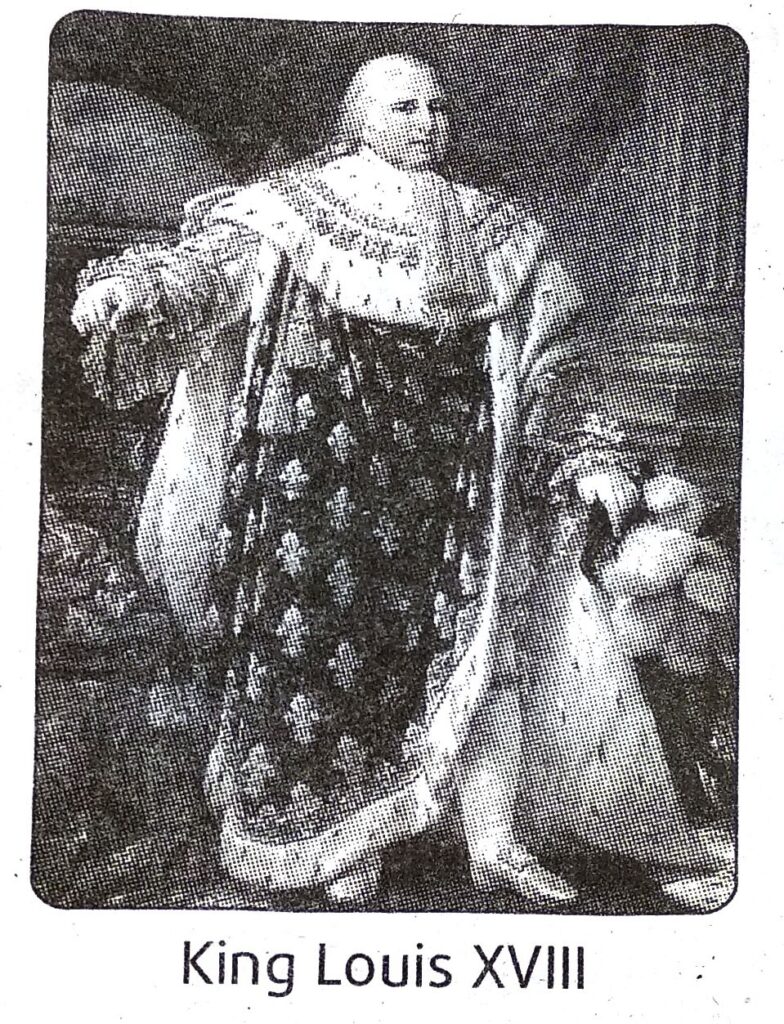
5. What were the main weaknesses of the Vienna Congress?
Ans. The system built at Vienna Congress (1815) did not last long. Its main weaknesses were –
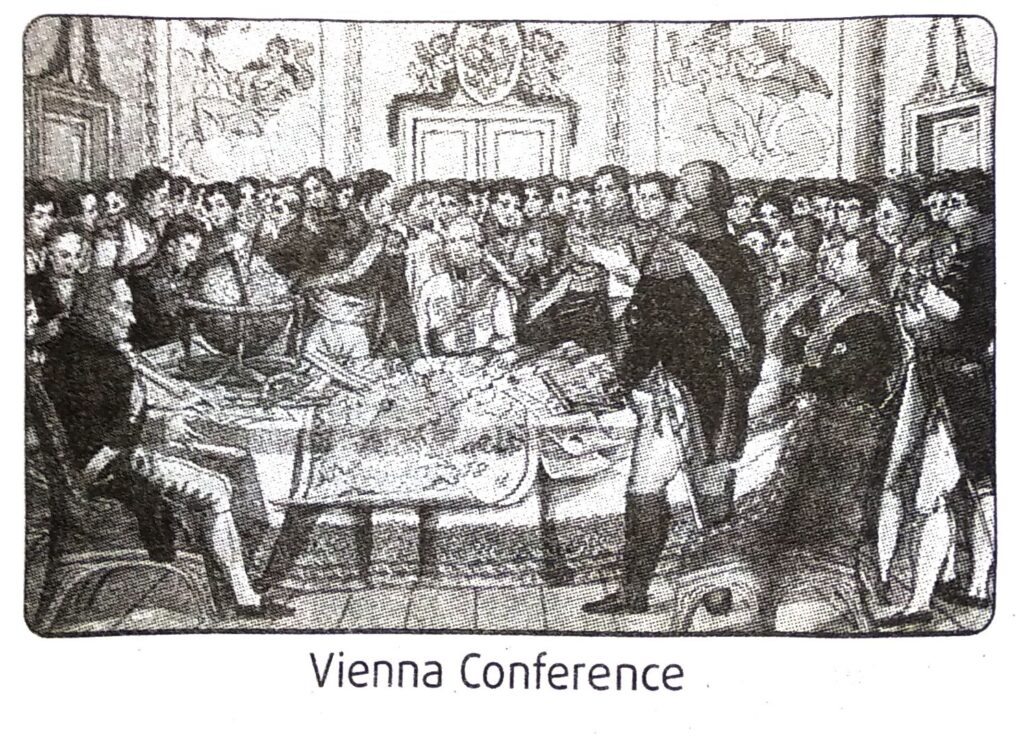
[1] It completely ignored the will of the people. The people did not forget the lessons of the French Revolution and demanded that the government should be formed so as to derive its right from the will of the governed.
[2] Moreover, in some countries like Germany and Italy, people who spoke the same language and were members of the same nationality were compelled to live in separate sates into which the countries were artificially divided.
6. What was the ‘Metternich System’?
Ans. From the year 1815 to 1848, the Austrian Minister Metternich was the most commanding personality of Europe. He was the central figure of European diplomacy. He represented reaction in its extreme form and was the enemy of both democracy and nationalism. His policy was the maintenance of status quo keeping things as they were. Hence he set himself to resist all demands for reforms, all struggles for national independence, all aspirations for selfgovernment. He aimed at making Europe go back to the condition prevailing before 1789.
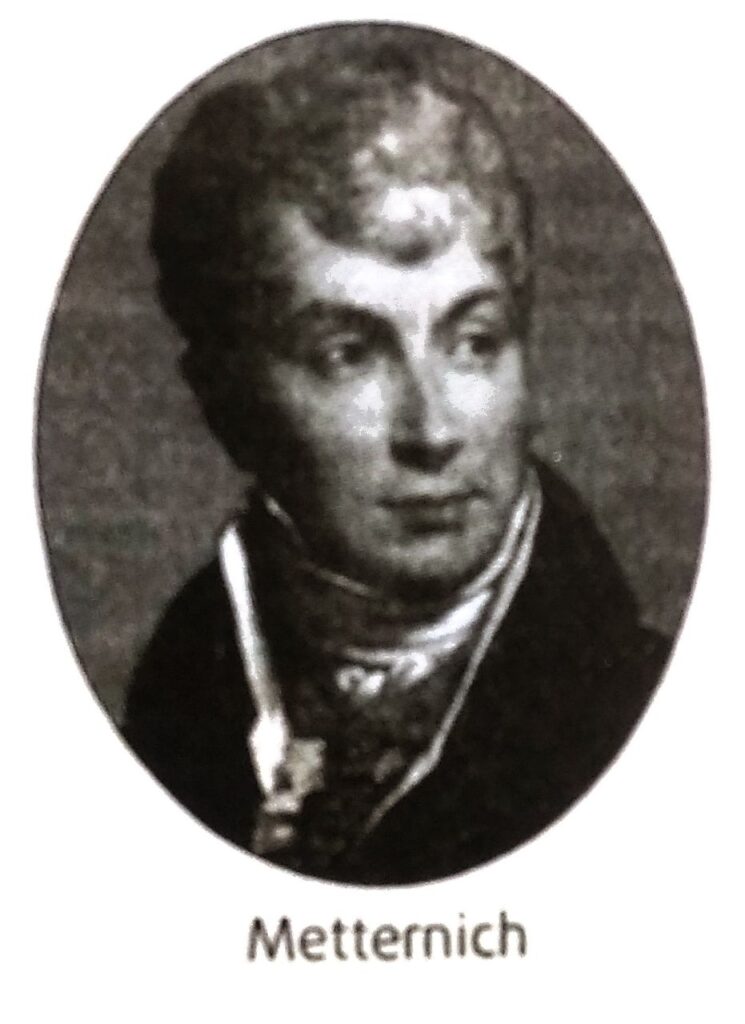
Know More
Metternich, who for thirty nine years had stood at the head of Austrian states, was forced to flee in disguise from Austria to England.
7. Why is the period between 1815 to 1848 known as the ‘Era of Metternich’?
Ans. Metternich was the most influential man of Europe from 1815 to 1848. After the fall of Napoleon Bonaparte in the Battle of Waterloo, Metternich became the central figure not only in the politics of Austria but in the politics of the whole of Europe. Owing to his unlimited influence, the period of 34 years (1815-1848) is called the ‘Age of Metternich’ in the history of Europe.
Know More
Metternich was born in 1773 in Koblenz (now in Germany). He was the descendent of an old Rhenish noble family. He studied diplomacy from University of Strasbourg and University of Mainz.
8. What was Carlsbad Decree?
Ans. The famous Carlsbad Decrees were a series of resolutions issued by a conference of ministers from the major German states, meeting at Carlsbad in Bohemia in 1819. Under the instruction of Metternich, the German Diet, passed the Carlsbad Decrees which sought to impose restrictions on student societies and the independence of the press. It was also proposed that a central investigating commission should be set up with powers to search conspiratorial organizations. These decrees curbed all forms of liberalism by tight control over liberal propaganda in Germany.
9 What do you mean by nation state?
Ans. A nation state refers to a sovereign state with well defined delineated boundaries, inhabited by people who are united by factors such as common descent, language, similar culture and ethnic character. It is also supposed to have a government of its choice. The people in a nation state are supposed to have cooperation, unity and strength.
Very Short Answer (VSA) type Questions
Answer in one sentence
1. What are the modern ideals born of the French Revolution?
Ans. The modern ideals born of the French Revolution are nationalism, liberalism and democracy.
2. Which dynasty was restored in France according to the Principle of Legitimacy?
Ans. The Bourbon dynasty was restored in France according to the Principle of Legitimacy.
3. Name the king who was restored to the throne of France according to the ‘Principle of Legitimacy’.
Ans. The king who was restored to the throne of France according to the Principle of Legitimacy was Louis XVIII.
4. Who were the members of the Concert of Europe?
Ans. The members of the Concert of Europe were Austria, Russia, Prussia and England.
5. What was the objective of the Principle of Legitimacy of the Vienna Congress ?
Ans. The objective of the Principle of Legitimacy of the Vienna Congress was to bring back the original ruling dynasties which used to rule in different parts of Europe before the outbreak of the French Revolution.
6. What was the objective of the Principle of Balance of Power of the Vienna Congress?
Ans. The objective of the Principle of Balance of Power of the Vienna Congress was to reconstitute the map of Europe in such a way that one state could not beat another in the race for power.
7. What was the objective of the Principle of Compensation of the Vienna Congress ?
Ans. The objective of the Principle of Compensation of the Vienna Congress was to reward those powers which played an important part in the defeat of Napoleon with the possession of different territories.
8. Name the countries which were benefitted by the Principle of Compensation.
Ans. The countries which were benefitted by the Principle of Compensation were [1] Austria, [2] Russia, [3] Prussia and [4] England.
9. What is ‘Concert of Europe’?
Ans. The Big Four-Austria, Prussia, England and Russia devised a system, known as the ‘Concert of Europe’ to maintain the political arrangement made in the Vienna Congress and to ensure peace in Europe.
10. Who were the Big Four at the Congress of Vienna?
Ans. The Big Four at the Congress of Vienna were Austria, Russia, Prussia and England.
11. What was the period of Metternich’s Prime Ministership?
Ans. The period of Metternich’s Prime Ministership was long 40 years from 1809-1848.
12. Which leader called the Congress of Vienna which tried to restore Europe to the way it was before Napoleon?
Ans. Metternich, the prince of Austria called the Congress of Vienna which tried to restore Europe to the way it was before Napoleon.
13. Where was the Vienna Congress held?
Ans. The Vienna Congress was held in Vienna, the capital of Austria.
14. When did the Metternich system end?
Ans. The Metternich system ended in 1848 as a result of the February Revolution.
15. Who was Metternich?
Ans. Metternich was the Prime Minister of Austria (1809-48) and the President of the Vienna Congress (1815).
16. Who was Castlereagh?
Ans. Castlereagh was the British Foreign Minister who represented England in the Vienna Congress.
17. What was the capital of Austria?
Ans. The capital of Austria was Vienna.
18. Who was the most influential leader at the Congress of Vienna?
Ans. The most influential leader at the Congress of Vienna was prince Metternich.
19. When did Metternich become the Prime Minister of Austria ?
Ans. Metternich became the Prime Minister of Austria in 1809.
20. Who represented France in the Vienna Congress?
Ans. Talleyrand represented France in the Vienna Congress.
21. When was the Congress of Troppau held ?
Ans. The Congress of Troppau was held in 1820.
Mark True or False
1. The Vienna Congress dismantled the Napoleonic empire.
2. The Vienna Congress marks the beginning of an era.
3. According to the Principle of Reward and Punishment, Poland was punished.
4. Metternich prided himself as the ‘vanquisher of Napoleon’.
5. Metternich was the Chancellor of Austria.
6. The period between the Vienna Settlement and the Revolution of 1848 is often dubbed as the Metternich Era in European politics.
7. The period between 1815 and 1848 is known as the ‘period of peace’.
8. After 1815 there was a conflict between monarchical and nationalist ideals.
9. Czar Alexander I was the leader of the Vienna Congress.
10. The Four Big Powers in the Vienna Congress were Russia, Austria, England and France.
11. After the fall of Napoleon Bonaparte, Louis XVIII of the Bourbon dynasty ascended the throne of France.
12. In accordance with the Principle of Balance of power, France was encircled with powerful states all around.
13. Metternich was the leader of the concert of Europe.
14. The July Revolution of 1848 paved the way for the destruction of Metternich system.
Answers :
1. True, 2. True, 3. True, 4. True, 5. True, 6. True, 7. False, 8. True, 9. False, 10. False, 11. True, 12. True, 13. True, 14. False,
Fill in the blanks
1. After the fall of Napoleon, European statesmen assembled at a conference at the Austrian capital _______
(Berlin/Vienna/Naples).
2. At the Congress of Vienna, Prussia was represented by _________ (Castlereagh/ Frederick William/Hardenberg).
3. In accordance with the principle of legitimacy, the ______ (Hohenzollern/Bourbon/ Stuart) dynasty was reestablished in France.
4. According to the Principle of Legitimacy the dominance of (France/Austria/Italy) over Germany was revived.
5. In accordance with the Principle of Legitimacy the House of Orange was restored in _________(France/Germany/Holland).
6. The conference at Carlsbad in 1819 was convened and dominated by ______ (Castlereagh/Metternich/Louis XVIII).
7. The period from 1815 to __________ (1830/1848/ 1850) is known as the age of Metternich.
8. The Carlsbad Decrees were a set of reactionary restrictions in the states of the _________ (French/Italian/German) confederation.
9. The President of German Confederation was __________ (Russia/Italy/Austria).
10. The Protocol of Troppeau was drafted in the year __________(1810/1820/1830) in the Concert of Europe.
11. The July Revolution of _________(1820/1830/ 1848) gave a death blow to Metternich system.
12. In accordance with the Principle of Balance of Power ________(Italy/France/Germany) was encircled with powerful states all around.
13. With the exception of ________(Frederich William III/Alexander I/Francis I) all the diplomats of the congress of Vienna were devoted to ‘ancien regime’.
Answers :
1. Vienna
2. Hardenberg
3. Bourbon
4. Austria
5. Holland
6. Metternich
7. 1848
8. German
9. Austria
10. 1820
11. 1830
12. France
13. Alexander I
Choose the best explanation
1. Statement: The period between 1815 to 1848 known as the ‘Era of Metternich’.
Explanation (A) : He became the Prime Minister of Austria.
Explanation (B) : He was the central figure at Vienna Congress.
Explanation (C) : He became the central figure in the politics of the whole Europe.
2. Statement: At Vienna Congress, as a punishment, Norway was snatched away from Denmark and was given to Sweden.
Explanation (A) : Metternich had enmity with the king of Denmark.
Explanation (B) : King of Denmark helped Napoleon against the Allies.
Explanation (C) : Denmark was an ally of Britain.
3. Statement: The leaders who took the most important part in defeating Napoleon met at Vienna.
Explanation (A) : They wanted to reconstruct the political map of Europe.
Explanation (B) : They wanted to establish a democratic government in France.
Explanation (C) : They wanted to liberate Italy from the hands of Austria.
Answers :
1. Explanation (C)
2. Explanation (B)
3. Explanation (B)
Multiple Choice Questions (MCQ)
1. The Congress of Vienna was held in the year –
A. 1814
B. 1815
C. 1816
D. 1817
Ans. B
2. The most important person of the Vienna settlement was –
A. Lafayette
B. Louis Philippe
C. Metternich
D. St. Simon
Ans. C
3 .The decision of the leaders of the Vienna Congress was to divide Poland into –
A. one division
B. three divisions
C. two divisions
D. four divisions
Ans. B
4. Nationalism means –
A. strong love for one’s own country without appreciation for other nations
B. strong devotion for one’s own country and hatred for others
C. strong love for all the countries of the world
D. strong devotion for one’s own country and its history and culture.
Ans. A
5. Liberal nationalism stands for –
A. freedom of all and equality before law
B. freedom of only male members of the society
C. freedom only for senior citizens
D. freedom of the monarch to rule the people
Ans. A
6. In Europe and in different parts of the world the concept of nationalism developed in full form in-
A. 16th century
B. 20th century
C. 18th century
D. 19th century
Ans. D
7. Which of the following countries did not attend the Congress of Vienna ?
A. Prussia
B. Britain
C. Switzerland
D. Russia
Ans. C
8. The Carlsbad Decree was declared in the year –
A. 1848
B. 1819
C. 1856
D. 1861
Ans. B
9. The Carlsbad Decree was declared in –
A. Germany
B. France
C. Russia
D. Italy
Ans. A
10. The Carlsbad Decree was declared by –
A. Talleyrand
B. Metternich
C. Louis VII
D. Charles X
Ans. B
11. In 1815 the Prime Minister of Austria was –
A. Alexander
B. Metternich
C. Louis XVI
D. Castlereagh
Ans. B
12. Metternich was the Chancellor of –
A. Austria
B. Russia
C. Italy
D. Britain
Ans. A
13. The father of European conservatism was –
A. Alexander I
B. Louis XV
C. Cavour
D. Metternich
Ans. D
14. The period of the Age of Metternich was –
A. 1816-1849
B. 1815-1848
C. 1850-1858
D. 1810-1828
Ans. B
15. The ‘Coachman of Europe’ was –
A. Talleyrand
B. Castlereagh
C. Metternich
D. Louis XVIII
Ans. C
16. The representative of defeated France in the Vienna Conference was –
A. Castlereagh
B. Metternich
C. Cavour
D. Talleyrand
Ans. D
17. The representatives of the Vienna Congress wanted to reestablish the dynasties which reigned in various states prior to Napoleonic wars according to the Principle of –
A. Compensation
B. Balance of Power
C. Legitimacy
D. Combination
Ans. C
18 According to the Carlsbad Decree of 1819 restrictions were imposed on –
A. social institutions of Germany
B. business organisations of Germany
C. German universities and other educational institutions
D. political institutions of Germany
Ans. C
19. Metternich to curb all forms of liberalistic ideas in the German universities imposed the –
A. Carlsbad Decree
B. Pedlar Decree
C. Milan Decree
D. Lyon Decree
Ans. A
20 Who said Italy is ‘only a geographical expression’?
A . Cavour
B. Metternich
C. Talleyrand
D. Louis XVIII
Ans. B
TOPIC – B
July Revolution of 1830
Explanatory Answer (EA) Type Questions
Answer in 12 to 15 sentences
1. What were the causes of the July Revolution of 1830 ?
Ans. The July Revolution of 1830 in France is an important chapter in the history of Europe. The following causes were responsible for the outbreak of the July Revolution in France.
[1] Reestablishment of the Bourbon dynasty: The Bourbon dynasty was reestablished in France according to the Principle of Legitimacy, but a large section of the people in France were not willing to accept the rule of the absolute Bourbon monarchs.
[2] Defects of the Constitutional Charter: Louis XVIII declared a Constitutional Charter just after his accession. In the charter the king reserved to himself the highest position in the country and the rights and interests of the common people were generally ignored.
[3] Unity among the different political parties: Though different political parties in France had different views there seemed to be a unity in the object of those parties who wanted to root out the Bourbon dynasty from France.
[4] The Repressive policy of Charles X: After the death of Louis XVIII, his brother Charles X who was a great reactionary succeeded to the throne of France. He reintroduced the administrative system of the ‘ancien regime’ and placed the aristocracy and the clergy in power. He also brought back those emigres who had left France during the Revolution and arranged to pay them suitable compensation.
In addition to the above, Charles X appointed Polignac as his Minister who was a staunch follower of reactionary principles. When the Chamber of Deputies passed the vote of no-confidence against the ministry of Polignac on 18 March, 1830, Charles X instead of accepting the resolution of the Chamber, dissolved it and ordered a new election. The people of France were highly aggrieved and had no other way to take but the path of revolt against Charles X.
[5] The July Ordinances of Charles X: The repressive policy of Charles X reached its climax when he issued the ordinances on July 26, 1830 by which he-[i] suspended the liberty of press, [ii] dissolved the Chamber of Deputies, [iii] changed the electoral system reduced the member of voters and [iv] ordered fresh elections. The four ordinances sounded a challenge and the Frenchmen retaliated by revolting against the ordinances by denying Charles X as the king of France.
The leadership of the Revolution of 1830 was led by Thiers. Charles X sent his forces to suppress the revolutionaries but failed. Ultimately the revolutionaries dethroned Charles X and set up Louis Philippe as the king of France (30 July, 1830).
Analytical Answer (AA) Type Questions
Answer in 7 to 8 sentences
1. What is the importance of the July Revolution of 1830?
Ans. The July Revolution of 1830 is one of the most important events in the history of France. From the following facts, it can be proved that the July Revolution was an event of utmost importance: [1] After the July Revolution, constitutional monarchy was established in France under Louis Philippe in place of the absolute monarchy of the Bourbons. [2] Before the July Revolution, the aristocracy and the clergy of France used to enjoy unlimited rights and privileges. However after the July Revolution all these classes were deprived of their privileges. [3] It affected not only France but almost all the countries of Europe. England, Germany, Spain, Portugal, Poland, Belgium, Switzerland and some other countries were affected by this revolution.
The July Revolution of 1830 was a death warrant for the autocratic monarchs.
2. What was the impact of July Revolution on France ?
Ans. The July Revolution is regarded as one of the most important events in the history of France and its impact on France was undoubtedly significant.
[1] The July Revolution succeeded in securing the revolutionary feelings i.e., liberty, equality and fraternity. [2] Although the July Revolution failed to remove the autocratic monarchy in France, the revolutionaries challenged the
principle of legitimacy and it was replaced by legitimacy of the nation. [3] In place of absolute monarchy of the Bourbons, constitutional monarchy was established under Louis Philippe. [4] The nobles, lords and clergy who enjoyed unlimited right and privileges were deprived of the privileges.
3. How was Rammohan Roy influenced by the July Revolution ?
Ans. The July Revolution of 1830 in France bore a rich legacy for the people of the world during the 19th and 20th centuries. This was because the ideals of liberty, equality, liberalism and democracy became popular among the people. These ideals spread rapidly from France to other countries of the world. Rammohan Roy, the ‘first modern man of India’ was greatly influenced by the July Revolution. He took an intense interest in the July Revolution which he viewed as a triumph of liberty. He celebrated the success of the July Revolution in France. He was an internationalist and supported the cause of freedom everywhere. Deeply influenced by the ideals of the Revolution Rammohan Roy thought of monarchy and its absolutism as great evils.
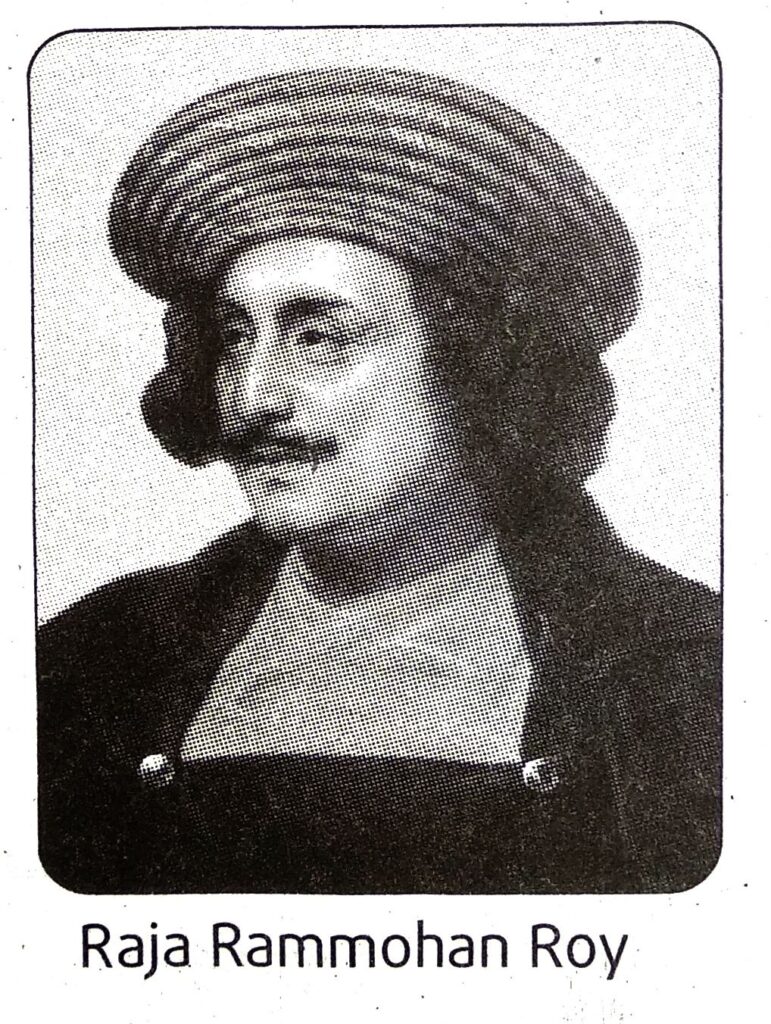
Short Answer (SA) Type Questions
Answer in 2 to 3 sentences
1. In which year and during whose reign July Revolution broke out ?
Ans. The July Revolution broke out in 1830 during the reign of Charles X.
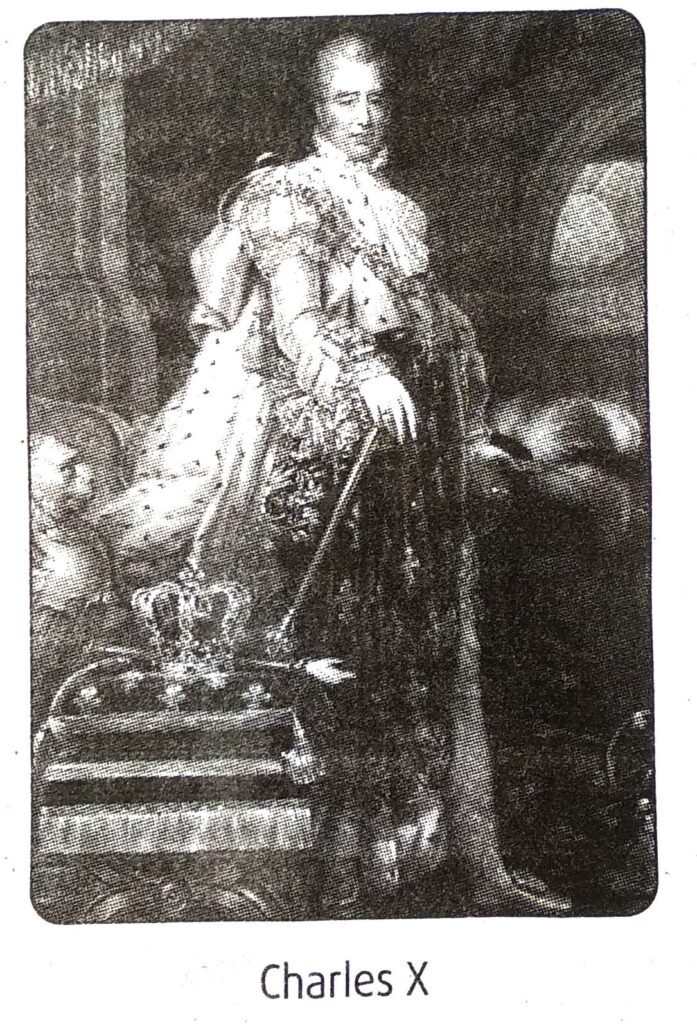
2. What do you mean by ‘July Monarchy’?
Ans. Louis Philippe was nominated by the French Parliament to be the constitutional monarch of France in 1830. His monarchy is also known as ‘July Monarchy’ because of its installation as a result of the Revolution that took place in the month of July.
3. What were the four ordinances issued by Charles X in 1830?
Ans. The four ordinances issued by Charles X in 1830 were: [1] Suspending the liberty of press [2] Dissolving the Chamber of Deputies [3] Changing the electoral system [4] Ordering fresh election.
4. What was the impact of July Revolution on Spain and Portugal?
Ans. The people of Spain and Portugal, being influenced by the July Revolution, agitated for the introduction of democratic government. Under the pressure of popular agitation the rulers of those countries introduced liberal administrative measures.
5. What was the immediate result of the July Revolution of 1830 ?
Ans. The immediate result of the July Revolution was the overthrow of Charles X, the French king. He was replaced by Louis Philippe, the Duke of Orleans. This hit hard the principle of legitimacy adopted by the Vienna Congress.
Very Short Answer (VSA) type Questions
Answer in one sentence
1. When did the July Revolution break out in France?
Ans. The July Revolution broke out in France in 1830.
2. What was the period of ‘July Monarchy’?
Ans. The period of July Monarchy was 1830-1848.
3. Name the countries where the impact of the July Revolution was felt.
Ans. The impact of the July Revolution was felt in Germany, Belgium, Poland, Spain, Portugal and England.
4. Name two leaders of the July Revolution.
Ans. Two leaders of the July Revolution were Thiers and Lafayette.
5. Name the countries which were inspired by the success of the July Revolution..
Ans. The countries which were inspired by the success of the July Revolution were Belgium, Poland, Portugal, Spain, England, Italy and Germany.
6. Who issued the ‘July Ordinance’ and when?
Ans. The July Ordinance was issued by The French emperor Charles X in 1830 (25 July).
7. Name the Bourbon king who was overthrown by the July Revolution in France.
Ans. The Bourbon king who was overthrown by the July Revolution in France was Charles X.
8. Who was Polignac?
Ans. Polignac was the minister of the French King Charles X, who issued arbitrary ordinances like restricting the freedom of press, diminishing the number of electors and curbing the voting rights of the people.
9. Who ascended the throne of France after the death of Napoleon?
Ans. After the death of Napoleon, Louis XVIII, the brother of Louis XVI of the Bourbon dynasty ascended the throne of France.
10. Who was the ruler of France when the July Revolution broke out?
Ans. Charles X was the ruler of France when the July Revolution broke out.
11. Who was the Prime Minister of the French king Charles X?
Ans. Polignac was the Prime Minister of the French king Charles X.
12. King of which dynasty was set up in France after the July Revolution?
Ans. After the July Revolution Louis Philippe of the Orleans dynasty was set up in France.
13. To which dynasty did Louis Philippe belong?
Ans. Louis Philippe belonged to the Orleans dynasty.
Mark True or False
1. The July Revolution of 1830 in France brought an end to the Divine Right of Kingship in France.
2. The king of France at the time of the July Revolution was Louis XIV.
3. Inspired by the July Revolution the Polish people began their fight for freedom against the Germans.
4. The July Ordinance was issued by the French emperor Charles X in 1830.
5. Lafayette was a leader of the July Revolution.
Answers :
1. True, 2. False, 3. False, 4. True, 5. True.
Fill in the blanks
1. The leader of the July Revolution was _________ (Guizot/Polignac/Thiers).
2.__________(Thiers/Polignac/
3. Louis Philippe came to the throne of France in __________ (1830/1836/1840).
4. _________ (Guizot/Polignac/Thiers) gave a call to the people of France to resist the illegal activities of the French government.
Answers :
1. Thiers
2. Polignac
3. 1830
4. Thiers
Choose the best explanation
1. Statement: The July Revolution is one of the most important events in the history of France.
Explanation (A) : It reformed the existing economic situation of France.
Explanation (B) : It helped to remove monarchy from France.
Explanation (C) : It succeeded in securing the revolutionary spirits (liberty, equality and fraternity).
2. Statement: After the Fall of Napoleon Louis XVIII sat on the throne of France.
Explanation (A) : According to the principle of Legitimacy Louis XVIII was reinstated on the throne of France.
Explanation (B) : The people of France elected Louis XVIII as the ruler of France.
Explanation (C) : The leaders of the Vienna Congress supported the accession of a weak monarch to the throne of France.
Answers :
1. Explanation (C)
2. Explanation (A)
Multiple Choice Questions (MCQ)
1. The July Revolution broke out in
A. 1820
B. 1830
C.1840
D.1850
Ans. B
2. The king of France during the July Revolution was
A. Napoleon
B. Charles X
C. Louis XVI
D. Louis Philippe
Ans. B
3. Polignac was appointed minister by
A. Charles X
B. Louis Philippe
C Napoleon
D. Francis II
Ans. A
4. The leadership in July Revolution was provided by
A. Thiers
B. Simon Bolivar
C. Polignac
D. Metternich
Ans. A
5. The task of the French Revolution of 1789 which remained incomplete by was complete the
A. French Revolution
B. February Revolution
C. July Revolution
D. Industrial Revolution
Ans. C
6. July Revolution broke out in
A. Italy
B. France
C. Germany
D. Britain
Ans. B
7. The July Revolution of 1830 sparked off on –
A. 29 July
B. 21 July
C. 27 July
D.30 July
Ans. C
8. July monarchy was established in France in –
A. 1815
B. 1828
C. 1848
D. 1830
Ans. D
9. July monarchy was established in France by –
A. Louis Philippe
B. Louis XVIII
C. Francis Ferdinand
D. Charles X
Ans. A
10. After the July Revolution the ruler who sat on the throne of France was –
A. Louis XVIII
B. Leopold
C. Cavour
D. Louis Philippe
Ans. D
11. The ruler of France who was dethroned after the July Revolution was –
A. Louis Philippe
B. Louis XVIII
C. Charles X
D.Metternich
Ans. C
TOPIC – C
February Revolution of 1848
Explanatory Answer (EA) Type Questions
Answer in 12 to 15 sentences
1. What were the causes of the February Revolution of 1848 in France?
Ans. After the downfall of Charles X in July 1830 Louis Philippe was made the king of France. It was expected that he would rule according to the aspirations of the people of France. But soon the people became dissatisfied with his administration. At last revolution broke out in 1848.
The causes of the outbreak of February Revolution are as follows:
[1] Economic: In France there was also and financial crisis. There agricultural crisis leading to high prices of bread. Artisans and labourers were thrown out of employment. Added to this was the famine of 1846 which led to crisis among the peasants. Inflation engulfed both the rural and urban population.
[2] Political: Louis Philippe held elections to the Chamber of Deputies in which only the bourgeois, the rich middle class could become members. The legislature passed laws for the benefit of the middle class and ignored the labourers, artisans and natural for the peasants. Therefore it common man to become hostile towards the king.
[3] Social: The Revolution of 1848 was the act of bourgeois liberals. From 1815 onwards they also wanted to protect the state against a reactionary nobility, who want to recover its former position. Despite the abolition of serfdom and the agrarian reform, feudal authority continued to exist.
[4] Constitutional: Louis Philippe did not extend the right of franchise in the country, but narrowed it down. He imposed restrictions on the freedom of press, speeches, articles, etc. The people who opposed this were imprisoned.
The last days of the reign of Louis Philippe were replete ‘with a general feeling of disappointment and discontent. The French Revolution on 1848 was the direct result of this existing atmosphere.
Analytical Answer (AA) type Questions
Answer in 7 to 8 sentences
1. Give an account of the February Revolution in France (1848).
Ans. Louis Philippe came to the throne of France on 30th July, 1830. After coming to the throne of France, Louis Philippe introduced some liberal reforms. He introduced freedom of press and declared France to be a secular state. He could not satisfy the different political parties of France and failed to keep pace with their ideals and aspirations. Popular discontent gradually increased and a movement under the leadership of Thiers started. People demanded the end of monarchy in France. Guizot, the Prime Minister, was not in favour of any administrative reforms. As the popular agitation took a serious turn Guizot was dismissed from office. An armed clash took place on 23 February in front of the house of
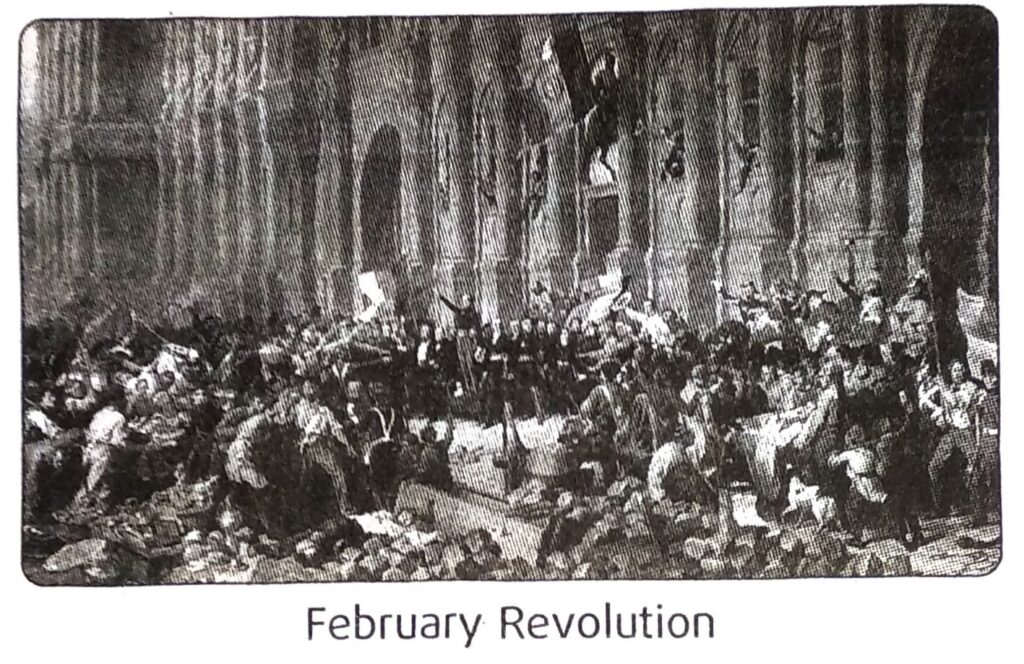
the deposed Minister Guizot in which many agitators were killed. This happened in the month of February and came to be known as the February Revolution. Louis Philippe abdicated and France was declared ‘Republic’.
2. Why is the year 1848 called the ‘Year of Revolution’?
Ans. After the outbreak of the February Revolution of 1848 against the autocratic rule of Louis Philippe, a revolt broke out in Vienna in the month of March. This revolt ultimately led to the downfall of Metternich. Later on revolts broke out in Austria, Germany and Italy. Crete and Hungary also followed the same example. The people of Rome raised their voice against Pope and he had to provide constitution to his people. The rulers of Holland and Denmark also had to provide new constitution to their people. The Revolution of 1848 also motivated the Chartist Movement of England. Thus the year 1848 is rightly called the ‘Year of Revolution’.
3. Who was Guizot? Write about his repressive policy.
Ans. Louis Philippe, the ruler of France, appointed Guizot as his prime minister. Guizot was a reactionary and supported autocracy of the king. His main aim was to maintain the policy of ‘status quo’ in France.
When the people of France placed their demands on Louis Philippe, through newspapers, meetings etc., the monarch on the advice of Guizot imposed restrictions on the meetings, speeches and newspapers. This was a direct attack on the freedom of speech of the people. Due to the repressive policy of Guizot there was anarchy and discontent everywhere in France. In this way, Guizot and his repressive policy added fuel to the fire of discontent of the people and the February Revolution broke out.
Short Answer (SA) Type Questions
Answer in 2 to 3 sentences
1. Mention any two effects of February Revolution outside France.
Ans. Two effects of February Revolution outside France were-[1] It was due to the February Revolution of 1848 that Metternich, who for thirty nine years handled the politics of all countries of Europe, was forced to resign. [2] The February Revolution of 1848 gave a new experience to the nationalists. As a result of this revolution the spirit of militarism grew in Europe.
2. Mention any two effects of February Revolution on France.
Ans. Two effects of February Revolution of France were: [1] The February Revolution brought an end to the monarchy of France and France was declared a Republic. [2] Through the Revolution of 1848 the people of France were able to establish their democratic rights permanently.
3. When and during whose reign did the and the February Revolution of 1848 break out ?
Ans. The February Revolution of 1848 broke out during the rule of Louis Philippe of the Orleans dynasty.
4. Mention two importance of the February Revolution of 1848.
Ans. February Revolution of 1848 brought an end to the monarchical system in France. It also brought an end to the Vienna Settlement.
Very Short Answer (VSA) Type Questions
Answer in one sentence
1. Which year is known as the Year of Revolution’ and why?
Ans. The year 1848 is known as the ‘Year of Revolution’ because the revolution which broke out in 1848 in France expedited national movements in 15 European countries.
2. Who was Louis Philippe ?
Ans. Louis Philippe of the Orleans dynasty was the ruler of France.
3. Who was Guizot ?
Ans. Guizot was the adviser and Prime Minister of Louis Philippe, the monarch of France.
4. Name the countries which were influenced by the February Revolution.
Ans. The countries which were influenced by the February Revolution were Germany, Italy, Austria, Hungary, Denmark, Netherland etc.
5. In which year did Louis Napoleon declare himself the ‘Emperor of France’?
Ans. On 1852 Louis Napoleon declared himself the Emperor of France.
6. When was Second Republic established in France?
Ans. Second Republic was established in France in 1848.
7. Which revolution influenced the establishment of Second French Republic in France ?
Ans.The February Revolution of 1848 influenced the establishment of Second French Republic in France.
8. When was the Second Empire established in France?
Ans. The French emperor Louis Napoleon (or Napoleon III) in 1852 put an end to the second French Republic and established the Second French Empire.
9. Who was Louis Kossuth?
Ans. Louis Kossuth was the nationalist leader of Hungary during the February Revolution.
Mark True or False
1. The foundation of Second French Republic was laid in 1840.
2. Louis Napoleon in 1852 ended the Second French Republic in France and established the Second Empire.
3. The book ‘Organisation of Labour’ was written by Louis Blanc.
4. The socialists under the leadership of Louis Philippe were eager to end the French Monarchy.
5. Guizot was the prime minister of king Louis Philippe.
Answers :
1. False, 2. True , 3. True , 4. False , 5. True.
Fill in the blanks
1. The Second French Empire was founded by ________ (Louis Napoleon/Napoleon Bonaparte /Louis XVI).
2. The Second French empire was founded in ______ (1851/1852/1853).
3. The foundation of the Second French Republic was laid in ________ (1830/1848/ 1858).
4. The year ________ (1848/1856/1864) is known as the ‘Year of Revolution’.
5. Louis Philippe, the ruler of France, abdicated to _________ (France/England/ Russia).
Answers :
1. Louis Napoleon
2. 1852
3. 1848
4. 1848
5. England
Choose the best explanation
1. Statement: The Revolution of 1848 brought about a change in the system of administration prevailing at that time.
Explanation (A) : Constitutional system of administration was recognised
Explanation (B) : Absolute monarchy was established in different countries of Europe.
Explanation (C) : In some countries of Europe autocratic rulers became popular.
2. Statement: Guizot, the Prime Minister of France, was dismissed from office by Louis Philippe.
Explanation (A) : Guizot rose in revolt against Louis Philippe.
Explanation (B) : Popular agitation took serious turn in France and Guizot was dismissed by Louis Philippe.
Explanation (C) : Guizot took part in an armed clash clash with the people and was dismissed.
Answers :
1. Explanation (A)
2. Explanation (B)
Multiple Choice Questions (MCQ)
1. The February Revolution broke out in France against the autocracy of –
A. Napoleon III
B. Metternich
C. Louis Philippe
D. Napoleon
Ans. C
2. The king of France during the February Revolution was —
A. Charles X
B. Louis XVI
C. Louis Napoleon
D. Louis Philippe
Ans. D
3. Third French Republic was established in –
A. 1792
B. 1830
C. 1848
D. 1870
Ans. D
4. The most influential Prime Minister of Louis Philippe was –
A. Guizot
B. Von Bulow
C. Turgo
D. Count Caprivi
Ans. A
5. “When France sneezes, the rest of Europe catches cold”-who said this?
A. Napoleon III
B. Bismarck
C. Metternich
D. Cavour
Ans. C
6. The socialists in France were eager to end the French Monarchy under the leadership of –
A. Karl Marx
B. Louis Blanc
C. Robert Owen
D. Charles Fourier
Ans. B
7. A movement demanding the enlargement of franchise started in France under the leadership of –
A. Louis Blanc
B. Guizot
C. Cavour
D. Thiers
Ans. D
8 After having declared his grandson heir to the throne, Louis Philippe sought asylum in –
A. Austria
B. Russia
C. Prussia
D. England.
Ans. D
9 Louis Napoleon in 1852 declared himself as the ‘Emperor’ with the title of –
A. Charles X
B. Napoleon
C. Napoleon I
D. Napoleon III
Ans. D
TOPIC – D
Unification of Italy
Explanatory Answer (EA) Type Questions
Answer in 12 to 15 sentences
1. Write the story of the unification of Italy. Or, How was Italy unified?
Ans. The unification of Italy in the nineteenth century is an important landmark in the history of Europe. Italy was divided into many small kingdoms. Taking advantage of this the big powers like France, Austria and Spain dominated over Italy.
[1] The secret revolutionary society, Carbonari took the initiative to unify and liberate Italy through an armed struggle. [2] The next step in the unification of Italy was led by Mazzini the founder of Young Italy movement. The mass uprising organised by young Italians for the unification and liberation of Italy ended in a failure. [3] After Mazzini, Cavour took the lead for Italian unification. He aimed to unify Italy under the leadership of Victor Emmanuel, the king of Piedmont. Cavour concluded the Pact of Plombieres (1858) with the king of France, Napoleon III for the liberation of Italy from Austrian rule. By the Peace of Villafranca (1859) Austria ceded Lombardy to Piedmont. [4] In the next stage Garibaldi, a great patriot and a follower of Mazzini, occupied Sicily and Naples and these were joined to Piedmont. [5] At last Venetia in 1866 and Rome in 1870 were joined to Italy and the Italian unification was complete.
2. What was the contribution of Count Cavour in the unification of Italy ?
Ans. Count Cavour took a leading part in the unification of Italy. The main elements of his policy were: [1] Austria should be driven away from Italy. [2] The Italian unification to be made under the leadership of Victor Emmanuel, the king of Piedmont. [3] It was impossible to unite Italy without seeking help from any foreign country.
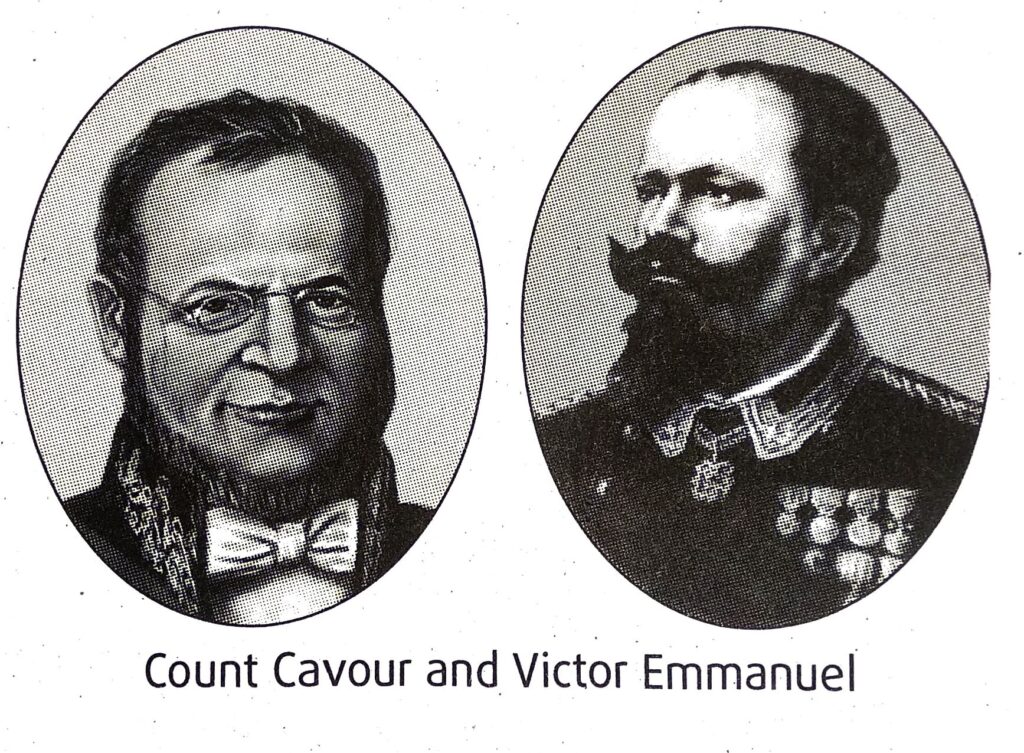
Cavour was appointed Prime Minister of Piedmont in 1852 by Victor Emmanuel. He concluded the Pact of Plombieres (1858) with the king of France Napoleon III for the liberation of Italy from Austrian rule. He induced the French emperor to come to the aid of the Sardinians when Austrian troops marched against Sardinia. In the Battles of Magenta and Salferino, the Austrians were defeated by the armies of Piedmont-Sardinia and the cities of Lombardy and Milan (1859) were occupied. Thereafter when Cavour was about to attack Venice, the French emperor suddenly withdrew from the war, leaving Sardinia to fight alone. Cavour thought it would be an act of extreme risk to continue to fight alone and preferred to come to terms by which Sardinia was allowed to rule over the enlarged kingdom of Italy, comprising its northern and central states. This marked a great step forward towards a united Italy.
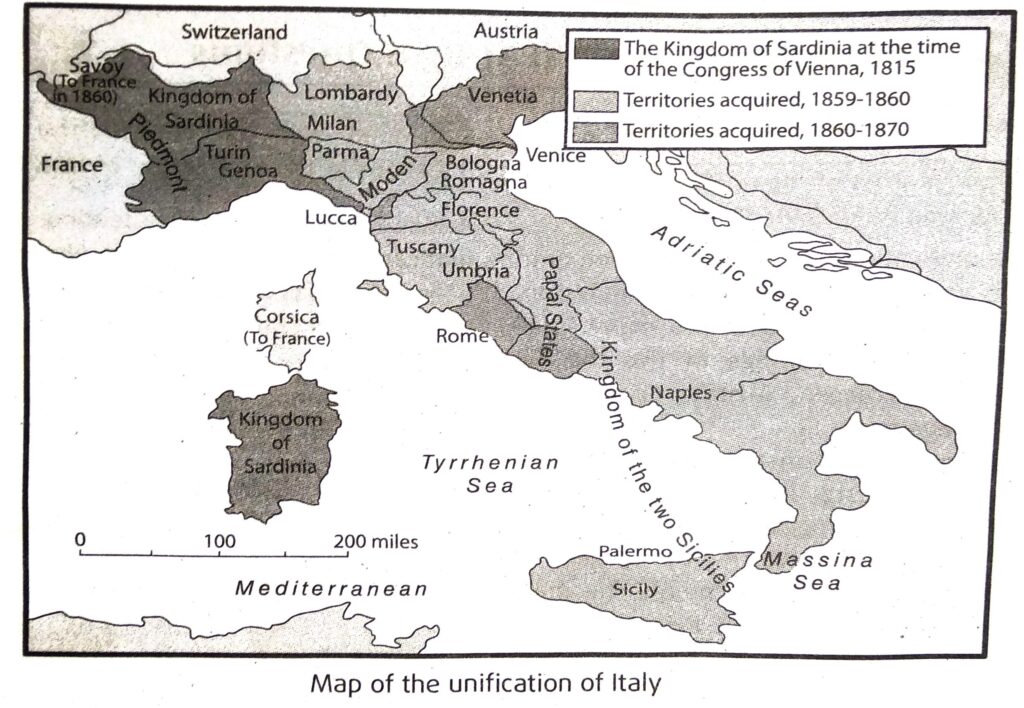
3. What was the contribution of Garibaldi was the to the unification of Italy ?
Ans. Garibaldi was a famous patriot of Italy. He was influenced by the ideas of Mazzini and he joined Young Italy. In 1860 the people of Sicily rose in revolt against their king Francis II of Naples. The rebels requested Garibaldi, to help them. Garibaldi decided to come ahead to help the Sicilians. An army of volunteers was organised at Genoa with one thousand of them wearing red shirts. Therefore, they were called the ‘Red Shirts’
On 5 May, 1860 the Red Shirts under the leadership of Garibaldi went to Sicily. It was called ‘Expedition of the thousands’. It seemed that the campaign would fail, for the king of Naples had 24,000 troops in Sicily and about 10,000 Naples. But fortune favoured Garibaldi. The army of Sicily was badly defeated by the soldiers of Garibaldi. Now he decided to take Naples also. In spite of a big army, the king of Naples could not fight with Garibaldi and fled. Garibaldi took possession over Naples.
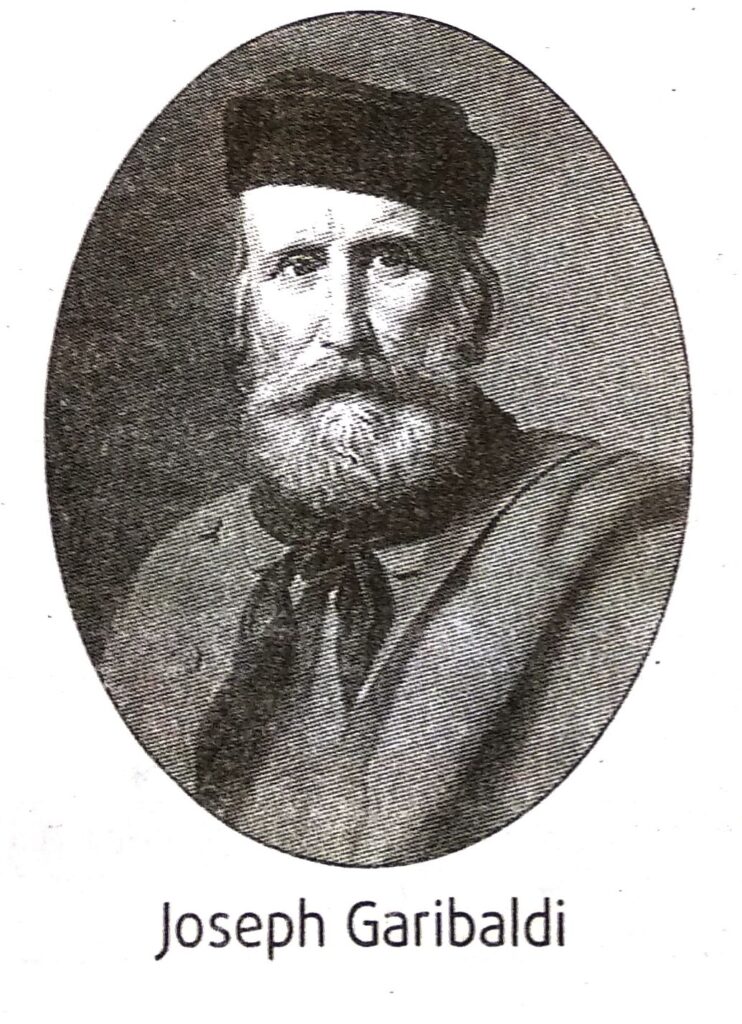
After freeing Sicily and Naples from the autocracy of Francis II, Garibaldi decided to attack Rome in order to complete the unification of Italy. But Cavour did not allow this because he apprehended that Garibaldi’s increased strength would be an impediment to Italian unification under the leadership of Piedmont-Sardinia. Garibaldi accepted the proposal and gave up all the conquered provinces in favour of Victor Emmanuel II.
Analytical Answer (AA) Type Questions
Answer in 7 to 8 sentences
1. What were the impediments to the unification of Italy ?
Ans. After the fall of Napoleon, Italy was divided into five principal political divisions in the Congress of Vienna and Austria became a dominant power in Italy. Italy was just reduced to a mere ‘geographical expression’. There were certain impediments to the unification of Italy. [1] The main impediment to the unification of Italy was the domination of Austria over Italian provinces. [2] The whole of Italy except Piedmont- Sardinia was under foreign rule who were not interested in Italian unification. [3] The leader of the Vienna Congress, Metternich followed an autocratic policy and destroyed the spirit of nationalism. [4] There was no organisation or Party at that time in Italy which could unite the patriots of Italy.
2. What was the contribution of Mazzini in the Italian unification movement ?
Ans. Mazzini was considered as the prophet of the Italian movement for unification. He was the founder of Young Italy movement. He founded a party known as Young Italy in 1832. He had immense faith in the power and strength of the Italian youths. Young men up to the age of forty could be its members. The objective of Young Italy were as follows:
[1] Italy should be unified as one nation.
[2] Austria should be driven out of Italy.
[3] Republic should be established in Italy.
[4] In the war against Austria foreign help was not necessary.
[5] Italian unification movement should be carried on by the Italians only.
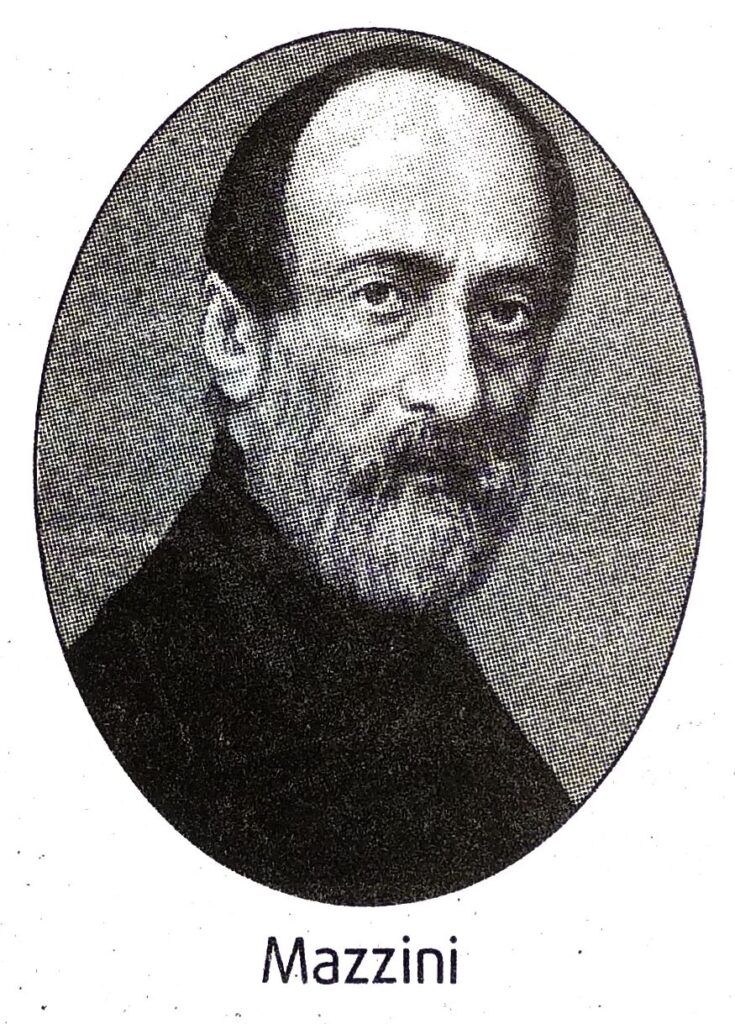
The mass uprising organised by the Young Italians for the unification and liberation of Italy ended in failure due to lack of organisation and plan of action among the rebels. His greatest contribution was that he could make the Italians realize that it was possible to have the dream of the unification of Italy materialised.
Short Answer (SA) Type Questions
Answer in 2 to 3 sentences
1. What did Napoleon do to unify Italy?
Ans. Before the conquest of Napoleon, Italy was divided into small petty kingdoms, mostly ruled by foreign rulers. When Napoleon conquered Italy he united the different provinces of Italy and enforced his laws known as Code Napoleon. He drove away the feudal lords and built roads to unite different parts of Italy.
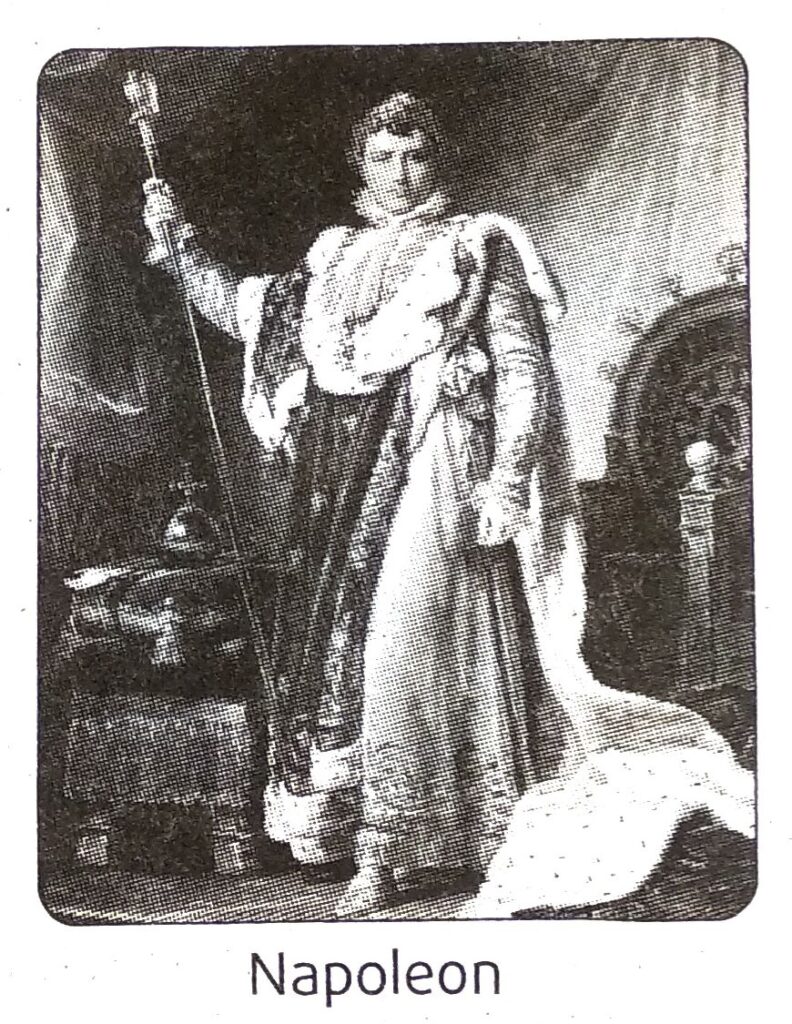
2. What was the condition of Italy before unification?
Ans. Italy, before unification, was a divided country.
[1] Besides Piedmont and the island of Sardinia, which were ruled by an Italian king in the north, the different parts of Italy were occupied by one or the other country. [2] Central Italy was ruled by the Pope, who was the head of the Church as well as of the Roman empire. [3] Austria occupied the northern part of Italy. [4] The southern part of Italy which included Naples and the island of Sicily was under the rule of the king of Naples. [5] Besides, many smaller parts of Italy were ruled by the princes of Austria.
3. Why was the Carbonari movement started in Italy ?
Ans. At the beginning of the 19th century, Italy was a geographical expression. The whole country was divided into a number of states. The rulers of each state were despots. The discontent against the existing system was first expressed in 1820 by a secret society.
4. What were the differences between the 20 two organisations of Italy-Carbonari and Young Italy?
Ans. Carbonari was a secret organisation of Italy where people of all age groups could join. But Young Italy was a youth organisation where any men upto the age of 40 could join.
The Carbonari was a secret society of the Italian rebles who wanted to liberate Italy through armed uprising. The members of Young Italy believed that organised mass uprising would bring Italian liberation.
5. What was ‘Young Italy’?
Ans. Joseph Mazzini was an inspiring leader of Italy. He founded a party known as Young Italy in 1832. He had immense faith in the power and strength of the Italian youths. Young men up to the age of forty could be its members.
6. Who was Mazzini ?
Ans. Mazzini was the arch priest of Italian nationalism. He was the founder of the Young Italy movement. He rejected the idea of taking the help of foreign powers for Italian liberation. He believed that Italian youth and people will liberate themselves by sacrifice.
7. What were the limitations of Mazzini’s 201 movement ?
Ans. The limitations of Mazzini’s movement were: [1] Mazzini was an idealist patriot but his programme of action was impractical. He was averse to take any help from any foreign power for the freedom of Italy. [2] Mazzini could not properly assess the military power of Italy. He could not realise that patriotism and self sacrifice were not sufficient in Italy’s fight against Austria.
8. What is ‘Risorgimento’?
Ans. Cavour, a leader of the Italian unification movement, pointed out that Italy should be united under the house of Piedmont and a moderate constitution with a parliament that will satisfy Italy’s needs and aspirations, should be framed. In his journal ‘Risorgimento’ he again and again preached this idea in order to make the movement more influential.
9. Mention two provisions of the Pact of Plombieres.
Ans. The Pact of Plombieres was signed between Napoleon III and Count Cavour in 1858. Two provisions of the Pact of Plombieres were: [1] Napoleon III agreed to support Piedmont in a war with Austria. [2] France was to get Savoy and Nice laying on her borders.
10. When and between whom was the Pact of Plombieres signed?
Ans. The Pact of Plombieres was signed in 1858 between Napoleon III and Count Cavour.
11. How did the Crimean War influence the Italian unification movement ?
Ans. The main impediment to Italian unity was Austria. To gain support of European powers and to isolate Austria, Italy took part in many European wars. In the Crimean War (1854) Italy sided with England and France. As a reward for participation in the Crimean War by Piedmont-Sardinia, Italy was allowed the privilege of attending Paris Peace Conference (1854). In the Paris Peace Conference the Italian question was raised before the European Statesmen and won the support of England and France.
Very Short Answer (VSA) Type Questions
Answer in one sentence
1 Which country stood in the way of unity and democracy in Italy ?
Ans. Austria stood in the way of unity and democracy in Italy.
2. Name the leaders who played the most important part in the unification of Italy.
Ans. The leaders who played the most important part in the unification of Italy were Mazzini, Cavour and Garibaldi.
3. Which treaty ended the Battle of Sadowa?
Ans. The Battle of Sadowa ended with the treaty 13 of Prague.
4. In which year and between whom was the Battle of Sedan fought?
Ans. The Battle of Sedan was fought in 1870 between Prussia and France.
5. In which year and between whom was the Battle of Sadowa fought ?
Ans. The Battle of Sadowa was fought in 1866 between Prussia and Austria.
6. In which year and between whom was the treaty of Villafranca signed?
Ans. The treaty of Villafranca was signed in 1859 between Austria and France.
7. Name the only state which was independent before unification of Italy.
Ans. The only state which was independent before the unification of Italy was PiedmontSardinia.
8. Name one secret society established during the Italian unification movement.
Ans. Carbonari was a secret society established during the Italian unification movement.
9. Who established Young Italy ?
Ans. Young Italy was established by Mazzini.
10. What is Carbonari ?
Ans. Carbonari was a secret society of Italy that aimed to unite Italy into a single state, to achieve liberty and drive the Austrians out of Italy.
11. When was the Italian complete? unification
Ans. The Italian unification was complete in 1870.
12. Who were called the ‘Red Shirts ?
Ans. Garibaldi’s followers were called the Red Shirts.
13. Who was the general of the Red Shirt volunteer force ?
Ans. The general of the Red Shirt volunteer force was Garibaldi.
14. What is the meaning of Risorgimento?
Ans. The meaning of Risorgimento is ‘rising again’.
15. Who said, “Italy is a mere geographical expression”?
Ans. Metternich, the Austrian Chancellor said, “Italy is a mere geographical expression”.
16. In which year was ‘Young Italy’ established by Mazzini?
Ans. Young Italy’ was established by Mazzini in 1832.
17. With which secret society was Mazzini associated?
Ans. Mazzini was associated with ‘Carbonari’, a secret society of Italy.
18. Who was the arch priest of Italian nationalism?
Ans. Joseph Mazzini was the arch priest of Italian nationalism.
19. What was the journal published by Count Cavour?
Ans. The name of the journal published by Count Cavour was Risorgimento.
Mark True or False
1. The Battle of Sadowa was fought in 1860.
2. The Battle of Sadowa was fought between Austria and Russia.
3. The Battle of Sedan was fought between France and Austria.
4. Carbonari was a secret society which was established during the German unification movement.
5. By the Peace of Villafranca (1859) Austria ceded Lombardy to Piedmont.
6. Cavour was the Prime Minister of Austria.
7. In the Battles of Magenta and Salferino the Austrians were defeated.
8. Mazzini believed that in the war against Austria, foreign help was necessary.
9. The Carbonari were so called because they used to burn charcoal.
10. Austria was merely a ‘geographical expression’.
Answers :
1. False, 2. False, 3. False, 4. False, 5. True, 6. False, 7. True, 8. False, 9. True, 10. False.
Fill in the blanks
1. Before unification of Italy, Naples and Sicily in South Italy was ruled by the __________ (Savoy/ Hapsburg/Bourbon) dynasty.
2. ________(Cavour/Garibaldi/
3. In 1860 some states of Central Italy like Perma, Modena and Tuscany expressed their desire to join __________ (France/Piedmont Sardinia/
4. ______(Italy/France/Germany) after the Vienna Congress was reduced to a mere geographical expression.
5. A united and independent Italy was born in _________ (1860/1865/1870).
6. The pact of Plombieres was signed in____________ (1848/1858/1862).
7. The Young Italians were disarmed by the __________ (French/British/Austrian) army.
8. In 1852 King Victor Emmanuel of _____ (Piedmont Sardinia/Lombardy/Milan) appointed Cavour as his Prime Minister.
9. Mazzini believed that war with _______(France/ Germany/Austria) was the only means to liberate Italy.
10. Mazzini favoured a _________(democratic/ republican/monarchical) form of government in a free Italy.
11. The Pact of Plombieres was signed between Napoleon III and __________(Garibaldi/Count Cavour/Mazzini).
Answers :
1. Bourbon
2. Cavour
3. Piedmont-Sardinia
4. Italy
5. 1870
6. 1858
7. Austrian
8. Piedmont Sardinia
9. Austria
10. republican
11. Count Cavour
Choose the best explanation
1. Statement: In Italy, a secret society ‘The Carbonari’ was established.
Explanation (A) : The purpose is to spread nationalist movement elsewhere in Europe
Explanation (B) : The purpose is to unite Italy into a single state.
Explanation (C) : The purpose is to express discontent against the existing system.
2. Statement: The Battle of Sadowa brought forth an important change.
Explanation (A) : The political centre of central Europe shifted from Vienna to Berlin.
Explanation (B) : The relation between Prussia and France became bitter.
Explanation (C) : Prussia and Spain came under the rule of the same dynasty.
Answers :
1. Explanation (B)
2. Explanation (A)
Multiple Choice Questions (MCQ)
1. Garibaldi’s men were called –
A. Red Shirts
B. Black Shirts
C. Brown Shirts
D. Blue Shirts
Ans. A
2. Napoleon III was the ruler of –
A. Piedmont-Sardinia
B. France
C. Germany
D. Austria
Ans. B
3. Carbonari was a secret society of –
A. Italy
B. Russia
C. France
D. Austria
Ans. A
4. Garibaldi, a great patriot of Italy occupied –
A. Sicily and Naples
B. Venetia
C. Rome
D Austria
Ans. A
5. Before unification Central Italy was ruled by –
A. Austria
B. Poland
C. Pope
D. France
Ans. C
6. In 1860, the Red Shirts under the leadership of Garibaldi went to –
A. Sicily
B. Lombardy
C. Tuscany
D. Modena
Ans. A
7. The Young Italy’ organisation was established by –
A. Mazzini
B. Cavour
C. Garibaldi
D. Napoleon III
Ans. A
8 The Journal ‘Risorgimento’ was edited by –
A. Mazzini
B. Cavour
C. Garibaldi
D. Leopold
Ans. B
9. The greatest impediment to Italian unification was –
A. Russia
B. Germany
C. Spain
D. Austria
Ans. D
10. The first king of united Italy was –
A. Cavour
B. Garibaldi
C. Napoleon III
D. Victor Emmanuel II
Ans. D
11. The brain of unification of Italy was –
A. Garibaldi
B. Cavour
C. Mazzini
D. Bismarck
Ans. B
12 The leadership in the Italian unification movement was given by –
A. Venice
B. Lombardy
C. Piedmont-Sardinia
D. Rome
Ans. C
13 . The leadership in Naples and Sicily was given by –
A. Mazzini
B. Cavour
C. Garibaldi
D. Louis XVI
Ans. C
14. The main centre of Carbonari, was –
A. Naples
B. Piedmont
C. Lombardy
D. Genoa
Ans. A
15. Count Cavour was appointed as the Prime Minister of –
A. Perma Modena
B. Rome
C. Tuscany
D. Piedmont-Sardinia
Ans. D
TOPIC – E
Unification of Germany
Explanatory Answer (EA) Type Questions
Answer in 12 to 15 sentences
1. How did B How did Bismarck unify Germany ?
Ans. Germany was divided into many small kingdoms for a long time. Each state was a separate unit and the rulers, whether foreign or German, were despots.
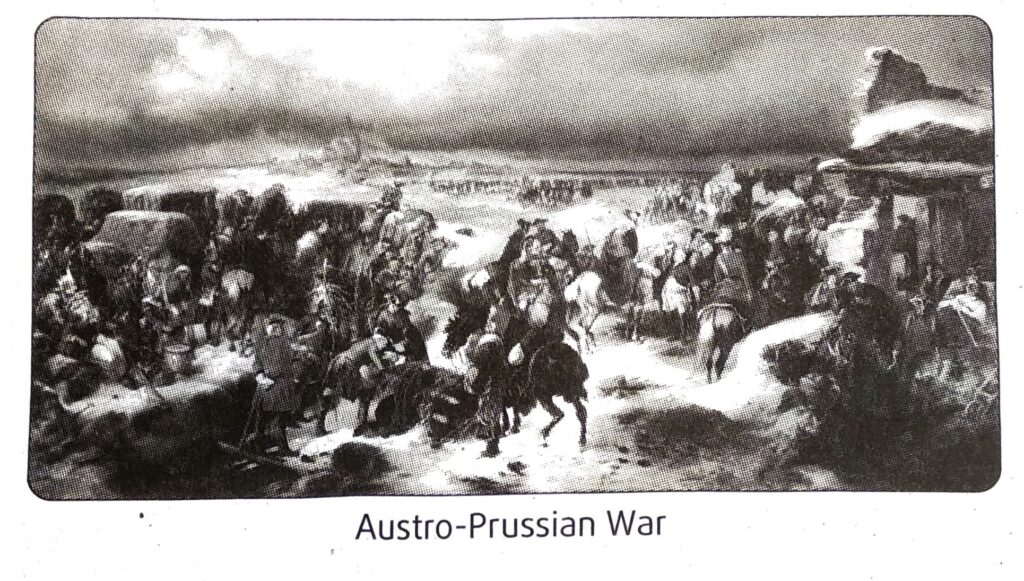
In Germany the movement towards a united Germany started among the German youths and students, but the movement failed to make any headway owing to Austria’s opposition. Germany found a leader who wanted to unite Germany. He was Otto Von Bismarck who became the Prime Minister of Prussia in 1861. “The great question of the day” he said, “would be decided not by speeches and majority resolutions… but by blood and iron”. According to him, the greatest obstacle to German unity was the presence of Austria in Germany. So expulsion of Austria was the first condition towards the achievement of German unity.
Bismarck accordingly prepared the ground, strengthened the Prussian army and then forced a war with Austria which is known as the Battle of Sadowa (1866). It ended Austria’s power over Germany and gave Prussia the power to reorganize the German states. Prussia lost no time in organizing the whole of northern and central Germany into a single kingdom under her leadership. Within four years, Prussia waged war on France whose ruler, Emperor Napoleon III was the friend and protector of the Catholic states of South Germany. The war ended in the defeat and capture of the French emperor in the Battle of Sedan (1870). This paved the way for the absorption of the Catholic states of the south enabling the unification of Germany under Prussia’s leadership. The king of Prussia now took the title of Kaiser, the emperor of Germany and the whole country stood united.
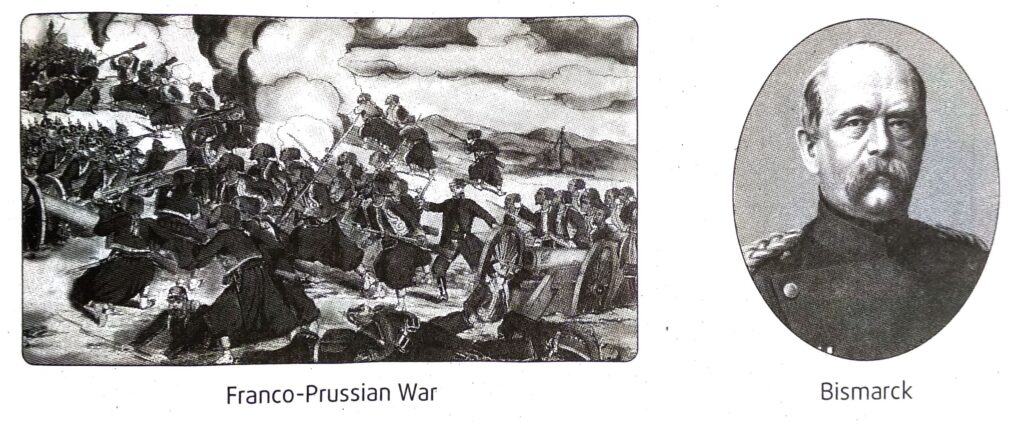
2. What were the steps through which Germany was unified ?
Ans. Like Italy Germany was divided into numerous small kingdoms.
[1] The first step to unify Germany was taken by Napoleon Bonaparte. After conquering Germany, Napoleon reduced the number of states to 39. [2] The second step in the unification of Germany was the creation of Zollverein, or the customs union of the German kingdoms through which all the German states agreed to follow a uniform tariff policy and complete free trade among different states. [3] The next step towards unification of Germany was Frankfurt Parliament (1849). The main function of this Parliament was to frame a constitution for Germany to achieve political unity and liberty and establish a popular government in place of the government of absolute monarch. [4] The next step was taken by Otto Von Bismarck, the leader of Germany, who was determined to unite all the kingdoms of Germany. He successfully waged war against Denmark in 1864 by which he obtained two German provinces-Schleswig and Holstein. [5] Next, the Prussian army defeated Austria in the Battle of Sadowa (1866). It ended Austria’s leadership in Germany. [6] Next, Germany defeated France in the Battle of Sedan 1870. This paved the way for the absorption of the Catholic States of the south enabling the unification of Germany under Prussia’s leadership. Thus emerged a unified Germany. William I was the first emperor of Germany.
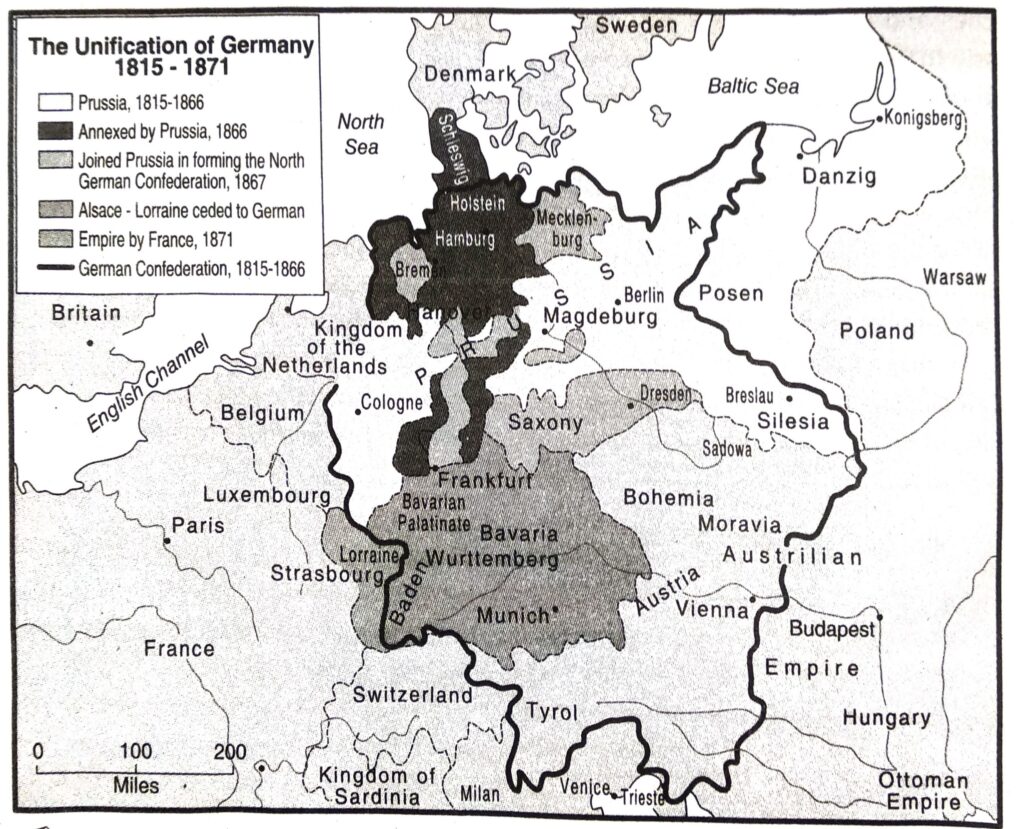
3. What is Ems Telegram?
Ans. In 1869 the Spanish throne became vacant. Leopold of the Prussian Hohenzollern family was invited by the Spaniards to become the king of Spain. With the possibility of both Prussia and Spain coming under the rule of the Hohenzollern family, the balance of power in Europe was threatened.
In these circumstances France put tremendous pressure on Spain as a result of which Leopold declined the offer. Not satisfied with this Napoleon III, the French king, sent his ambassador Count Beneditti to the Prussian emperor William I to get an assurance that none of the Hohenzollern dynasty would ever lay claim to the throne of Spain.
The Prussian emperor William I was enjoying his holiday at Ems. He politely refused to make such a promise to Beneditti. A report on the whole matter was sent to Bismarck by a telegram (13th July, 1870). Bismarck immediately found. an opportunity after reading this famous ‘Ems Telegram’. Bismarck abridged the telegram in such a way that it appeared to the French that their ambassador Beneditti was insulted and it appeared to the Prussians that their king was insulted. Bismarck had the abridged telegram published in the newspaper. This infuriated the French. An outcry for a war against Prussia grew and war was declared by France on 19th July 1870.
Analytical Answer (AA) Type Questions
Answer in 7 to 8 sentences
1. What was the Confederation of the Rhine ?
Ans. The first step to unify Germany was taken by Napoleon Bonaparte. During the French Revolution Germany was divided into 300 states under Austrian domination. Napoleon used the German states as an instrument of crushing the political power of Austria and Prussia. Napoleon realised that invasion of France by Austria and Prussia could be easily removed by the reorganisation of the German states. Napoleon formed 39 states out of the 300 states and inaugurated federal administrative system known as the Confederation of the Rhine.
2 . What was the Frankfurt Parliament?
Ans. The national leaders of Germany established a Parliament whose members were electede on the basis of universal adult franchise. The main function of this Parliament was to frame a constitution for Germany to achieve the political unity and liberty and establish a popular government in place of the government of absolute monarchy.
According to the decisions of the Frankfurt Parliament, the crown of a united Germany was offered to Frederick William. But he refused this offer. His view was that he should not receive the crown as a gift from the representatives of the people. He believed in the unification of Germany through sheer force.
3. Bismarck fought three wars to achieve the complete unification of Germany Discuss.
Ans. Germany was divided into many small kingdoms for a long time. Bismarck, the leader of Germany, was determined to unite all the kingdoms of Germany. He fought three wars to achieve the complete unification of Germany.
[1] War on Denmark (1864): Bismarck waged war against Denmark in 1864. Denmark surrendered the two provincesSchleswig and Holstein to Austria and Prussia. The Treaty of Gastin (1865) was signed between Austria and Prussia. But Bismarck wanted Austria to teach a lesson.
[2] Austro-Prussian War (1866): Next the Prussian army defeated Austria in the battle of Sadowa (1866). It ended Austria’s leadership in Germany.
[3] Franco-Prussian War (1870-71): Next Germany defeated France in the Battle of Sedan in 1870. France was compelled to sign the humiliating Treaty of Frankfurt (1871). Thus emerged a unified Germany.
Short Answer (SA) Type Questions
Answer in 2 to 3 sentences
1. What was Zollverein ?
Ans. The first stage in the unification of Germany was the creation of Zollverein or the customs union of the German kingdoms. The terms of the Zollverein were complete free trade between states and uniform tariff on all frontiers.
2. What did Napoleon do to unify MELONE Germany ?
Ans. The first step to unify Germany was taken by Napoleon Bonaparte. During the French Revolution, Germany was divided into 300 states under Austrian domination. After conquring Germany Napoleon united the kingdoms and formed 39 states out of the 300 states and inaugurated a federal administrative system known as the Confederation of the Rhine in 1806.
3. What were the two main obstacles in the unification of Germany ?
Ans. Two main obstacles in the unification of Germany were: [1] The president of the Confederation of the Rhine, Austria was against the unification of Germany. [2] There were differences in ideology of the people of northern and southern Germany.
4. What was the aim of Frankfurt Parliament?
Ans. The aims of Frankfurt Parliament. was[1] to achieve the political unity and liberty of Germany and [2] to establish a popular government in place of the government of absolute monarchy.
5 . Who was Bismarck? Who was Bis
Ans. Bismarck was the Prime Minister of Prussia. He followed the policy of ‘Blood and Iron’ and unified Germany under the leadership of Prussia. He took part in three wars for uniting Germany [1] war against Denmark (1864), [2] war against Austria (1866) and [3] war against France (1870).
6. What was the policy of ‘Blood and Iron’?
Ans. According to Bismarck the greatest obstacle to German unity was Austria. He used to say that the greatest question of the day would be decided not by speeches and majority resolutions but by a policy of ‘blood and iron’. His motto was to oust Austria from Germany if possible by diplomacy, if necessary by ‘blood and iron’ or war.
7. What were the results of the Battle of Sedan ?
Ans. In the battle of Sedan (1870) France was defeated by Germany. It paved the way for the unification of Germany under Prussia’s leadership. Germany was unified and William I became the first emperor of united Germany.
8. What were the wars waged by Bismarck for the unification of Germany?
Ans. Bismarck waged three wars for the unification of Germany. These were[1] Danish war (1864), [2] Austro-Prussian War and (1866) [3] Franco-Prussian War (1870).
9. Mention two importance of the Battle of Sadowa.
Ans. In the battle of Sadowa (1866) the Prussian army defeated Austria. It ended Austria’s leadership in Germany and paved the way for the unification of Germany.
Very Short Answer (VSA) Type Questions
Answer in one sentence
1. In which year was the treaty of Frankfurt signed ?
Ans. The treaty of Frankfurt was signed in 1871.
2. After which battle Germany became united?
Ans. Germany became united after the Battle of Sedan in 1870 fought between France and Prussia.
3. What is ‘Pan-Germanism’ ?
Ans. ‘Pan-Germanism’ means the idea or sentiment of a united German people which developed in Germany under the influence of poets, philosophers and historians like Bohmer, Fichte, Hegel, Hausser etc.
4. Who was the real architect of the unification of Germany ?
Ans. The real architect of the unification of Germany was Bismarck.
5. Who became the emperor or ‘Kaiser’ after German unification?
Ans. The Prussian king William I became the emperor or Kaiser after German Unification.
6. Between whom was the treaty of Frankfurt signed ?
Ans. The treaty of Frankfurt was signed between Prussia and France.
7. What is ‘Confederation of the Rhine’?
Ans. Napoleon Bonaparte formed forty-nine states out of the former three hundred states in Germany and inaugurated a federal administrative system in Germany known as the Confederation of the Rhine.
8. Who followed the policy of ‘Blood and Iron’?
Ans. Otto Von Bismarck followed the policy of ‘Blood and Iron’.
9. Who was Count Beneditti?
Ans. Count Beneditti was the ambassador of the French king Napoleon III to the Prussian emperor William I.
10. Who was known as the ‘Iron Chancellor’?
Ans. Bismarck, the leader of German unification, was known as the Iron Chancellor.
11. Between whom was the Treaty of Villafranca signed?
Ans. The Treaty of Villafranca was signed between the French emperor Napoleon III and Austria.
12. In which year Bismarck became the Prime gel Minister of Prussia?
Ans. Bismarck became the Prime Minister of Prussia in 1862.
13. Where was the Confederation of Rhine formed?
Ans. The Confederation of Rhine was formed in Germany.
14. In which year was the Confederation of Rhine formed?
Ans. The confederation of Rhine was formed in 1806.
15. Who became the Emperor of united Germany?
Ans. Kaiser William I became the emperor of united Germany.
16 . When was the Treaty of Gastein signed ?
Ans. The Treaty of Gastein was signed in 1865.
17 What were the two Duchies which were divided between Austria and Prussia according to the Treaty of Gastein?
Ans. According to the Treaty of Gastein the two Duchies Schleswig and Holstein were divided between Austria and Prussia.
Mark True or False
1. Before the rule of Napoleon, Germany was divided into several small kingdoms.
2. The foundation of the Frankfurt Parliament was an important step towards German unification.
3. Bismarck planned for the unification of Germany under the leadership of Prussia.
4. Metternich followed the policy of ‘Blood and Iron’.
5. Count Benedetti was sent by Napoleon III to the Prussian king to get assurance that none of the Prussian dynasty would ever lay any claim on the Spanish throne.
6. The treaty of Berlin (1878) under the leadership of Bismarck tried to solve the Balkan question.
7. The Treaty of Zurich was signed in 1869 between Austria and Piedmont-Sardinia.
8. After the battle of Sadowa Germany was united.
Answers :
1. True, 2. True, 3. True, 4. False, 5. True, 6. True, 7. False, 8. False.
Fill in the blanks
1. The first stage in the unification of Germany was the creation of __________ (Zollverein/Philiki Hetaira/Carbonari).
2. _________(1848/1849/1850) the German nationalists convened a parliament called Frankfurt Parliament.
3. Under the rule of ________(Metternich/ Napoleon/Bismarck) the Germans became acquainted with democratic and nationalist ideas.
4. The Confederation of the Rhine was inaugurated by _______(Louis Philippe/ Napoleon/Mazzini).
5. During the French Revolution Germany was divided into ________ (300/400/500) large and small states.
6. The leadership in the Germany was given by unification of ________ (Russia/ Prussia/Lombardy).
7. The _________ (Danish/Spanish/ Prussian) war was the first step towards German unification.
8. After a crushing defeat at, _________(Sadowa/ Sedan/Waterloo) France was compelled to sign the treaty of Frankfurt.
9. The German states formed a tariff organisation on the basis of commercial cooperation known as______ (Carbonari/Kulak/Zollverein).
10. The German unification was completed with the declaration of the _________ (Russian/ Prussian/Italian) king as the ‘Emperor of Germany’.
Answers :
1. Zollverein
2. 1848
3. Napoleon
4. Napoleon
5.300
6. Prussia
7. Danish
8. Sedan
9. Zollverein
10. Prussian
Choose the best explanation
1. Statement: France signed the Treaty of Frankfurt with Prussia in 1871.
Explanation (A) : France was defeated at the battle of Sedan.
Explanation (B) : France did not fight but surrendered to Prussia.
Explanation (C) : Both France and Prussia agreed to support each other by the Treaty of Frankfurt.
2. Statement: Bismarck signed the Treaty of Gastein with Austria.
Explanation (A) : Bismarck’s aim was to take the help of Austria for German unification.
Explanation (B) : Bismarck’s aim was to settle the confrontation with Austria.
Explanation (C) : The treaty was a temporary solution and Bismarck resolved to teach Austria a proper lesson in time.
Answers :
1. Explanation (A)
2. Explanation (C)
Multiple Choice Questions (MCQ)
1. How many wars did Bismarck fight to unify Germany ?
A. Three
B. Four
C. Five
D. Six
Ans. A
2. Bismarck successfully waged war against Denmark in
A .1862
B. 1861
C. 1864
D. 1868
Ans. C
3. The main function of Frankfurt Parliament was to frame a constitution for –
A. Italy
B. Germany
C. France
D. Russia
Ans. B
4. According to the decisions of Frankfurt Parliament, the crown of a united Germany was offered to
A. Alexander I
B. Francis II
C. Frederick William
D. Louis Philippe
Ans. C
5. The leader of German unification movement was
A. Hitler
B. Mussolini
C. Mazzini
D. Bismarck
Ans. D
6. Germany defeated ofFrance in the battle of
A. Sadowa
B. Sedan
C. Jena
D. Trafalgar
Ans. B
7. The Battle of Sadowa was fought between
A. Denmark and Russia
B. France and Russia
C. Austria and Prussia
D. Prussia and Russia
Ans. C
8. Which treaty ended the Battle of Sadowa ?
A. Treaty of Plombieres
B. Treaty of London
C. Treaty of Prague
D. Treaty of Villafranca
Ans. C
9. The Frankfurt Parliament was convened in
A. Russia
B. Italy
C. Germany
D. England
Ans. C
10. The Frankfurt Parliament was convened in the year
A. 1830
B. 1848
C. 1861
D. 1862
Ans. B
11. A master of political and diplomatic juggling
A. Bismarck
B. Cavour
C. Napoleon III
D. William I
Ans. A
12. The Zollverein was formed under the leadership of
A. Austria
B. Italy
C. Savoy
D. Prussia
Ans. D
13. Who was the first emperor of unified Germany ?
A. Napoleon III
B. William I
C. Bismarck
D. Cavour
Ans. B
14 .The first stage in the unification of Germany was the creation of
A. Zollverein
B. Confederation of the Rhine
C. Frankfurt Parliament
D. Bundestag
Ans. A
15. Who took the first step to unify Germany ?
A. Bismarck
B. Napoleon Bonaparte
C. Count Cavour
D. Hitler
Ans. B
16. Ems Telegram was published on
A. 10th July, 1870
B. 13th July, 1870
C. 17th July, 1870
D. 19th July, 1870
Ans. B
17. According to Bismarck the greatest obstacle to Germany unity was
A. Austria
B. Russia
C. Poland
D. France
Ans. B
TOPIC – F
Ottoman Empire and Balkan Nationalism; Abolition of Serfdom in Russia
Explanatory Answer (EA) Type Questions
Answer in 12 to 15 sentences
1. What were the causes of the Crimean War ? How did the Crimean War lay the foundation of the unification of Italy ?
Ans. The Crimean War was an important event in the history of Europe. Nicholas I the Czar of Russia followed a policy of expansionism in Turkey. The increasing Russian dominance in Turkish affairs roused suspicion among the European powers like England, Austria, France. All the three powers had anti-Russian attitude. They followed a policy of containing Russian expansionism in the Turkish empire. Russia, England, France and Austria met at Vienna and prepared a note in order to avoid the possibilities of war and to maintain peace in the Turkish empire. In the Vienna Note, Russian guardianship over the orthodox Greek Church in Turkey was accepted while Russia was asked to withdraw all other claims on Turkey. But the proposals of the Vienna note was rejected by Russia. So England and France declared war against Russia in support of Turkey which is known as the Crimean War (1854).
The Crimean War (1854) laid the foundation of the unification of Italy. Cavour, the Prime Minister of Piedmont, was a great diplomat. He wanted to unify Italy but at the same time he knew that Italy could not be unified without driving out Austria from Italy and that was quite impossible without foreign help. He wanted to put the Italian question’ on international platform. He, therefore, sent his soldiers to the Crimean War in support of the Allies. He soon achieved success in his object when he was invited to the Treaty of Paris. He succeeded in gaining sympathy of the Allies.
2. How did the Greeks achieve their w did independence?
Ans. Greece, the cradle of ancient European civilisation, was conquered by Turkey. In the 18th century there was a revival of Greek learning, history and culture which inspired them with a spirit of nationalism. Moreover, the nationalist and democratic ideals of the French Revolution inspired them with the ideas of freedom.
The struggle of the Greeks originated in the activities of the Philke Hetaire (a secret society for friendly brotherhood) formed in Odessa (now in Ukraine) in 1814. Its main objective was to spread the doctrine of liberty and expel the Turks from Europe.
Uprisings first started in Moldavia and Wallachia in 1821 under the leadership of Alexander Ypsilanti but were suppressed by the Turkish government. Meanwhile, rebellion broke out in Morea in South Greece and in the Aegean islands. Russia, with the aim of occupying some parts of Turkey, came to help the Greek rebels. In order to curb Russian influence in Greece both England and France joined the war. The combined Anglo-French-Russian navy destroyed the Turkish navy in the Battle of Navarins. While the English and French fleet withdrew, Russian army totally routed the Turks and forced Turkey to sign Treaty of Adrianople in 1829. By this treaty Greece became independent under Russian protection.
3. Give a pen picture of the life of the serfs in Russia. Who was known as ‘Czar the Liberator and why ?
Ans. There were about 45 million serfs in Russia comprising 50% of the total population. The condition of the serfs was miserable. They were treated like animals by their masters. They could be auctioned. They were subjected to physical punishment. The serfs were tied to the lords for everything and had no freedom. The law did not recognise or protect their rights.
Czar Alexander II abolished serfdom and came to be known as ‘Czar the Liberator’. The Russia’s serf system was detrimental to progress. The unskilled, illiterate serfs were unfit to work in the factories or in the modern agricultural farms. Serf system lost its utility and became a barrier to economic progress of Russia. By the Emancipation Statute of 1861, the Russian serfs were declared free. They were granted civil rights equal to those of the free peasants. All the rights of the lords on the serfs ceased to exist. They were granted full freedom. The liberated serfs could own property, engage in business and were free to marry at their will. The land to be received by the serfs was to be fixed by magistrates called Arbiters of Peace.
4 . What were the main features of Czar Alexander Il’s Emancipation Statute ?
Ans. There were about 45 million serfs in Russia comprising 50% of the total population. The condition of the serfs was miserable. They were treated like animals by their masters. Czar Alexander II passed the ‘Emancipation Statute’ in 1861 and abolished serfdom. The main features of the ‘Emancipation Statute’ were as follows: [1] The Russian serfs were declared free. They were granted civil rights equal to that of the free peasants. [2] All the rights of the lords on the serfs ceased to exist. [3] The serfs were granted full freedom. The liberated serfs could own property. engage in business and were free to marry at their will. [4] The landed estates of the lord were to be divided into two parts. The serfs would get 50% of the land they used to cultivate under the lords. . [5] The serfs must pay the landlord for the land received from him. Since the serfs had no money to pay, the government would advance the money to the lords on behalf of the serfs. The serfs were to pay back to the government in 49 installments. [6] The land was not vested with individual serfs, but the village mirs got the land and controlled it.
Analytical Answer (AA) Type Questions
Answer in 7 to 8 sentences
1. What led to the rise of Balkan nationalism ?
Ans. The Balkan nations like Greece, Egypt Romania, Serbia, Albania and others were white-skinned Europeans and Christian by religion. The causes of the rise of Balkan nationalism are as follows: [1] The Balkan nationalities were ruled by the Asiatic and Islamic power Turkey. Turkey followed a policy of Turkofication. The French Revolution inspired the Balkan nationalities to agitate against Turkish rule. [2] The Turkish Sultanate ruled the Balkan people through military force and the people of the Turkish empire owed no allegiance to the Sultan. [3] The Christians of the Balkan peninsula were oppressed by the ruling Sultans of Turkey. [4] During the later seventeenth century, Turkey’s power was gradually declining. The civil administration and the army became weak and failed to keep the Balkan people under their control.
2. What is the significance of the Greek War of Independence ?
Ans. The Greek War of Independence is a landmark in the history of Europe. [1] It showed that the resolutions of the Congress of Vienna were impractical and that national forces could not be checked by reactionary guiding principles. [2] The Greek War of Independence was a great blow to the Metternich system. [3] The European powers were attracted towards the near east for the first time. [4] They felt that each had a common interest in the region. They also felt the need to free the Christian states from the oppressive Turkish rule. [5] The weakness of Turkey was also exposed.
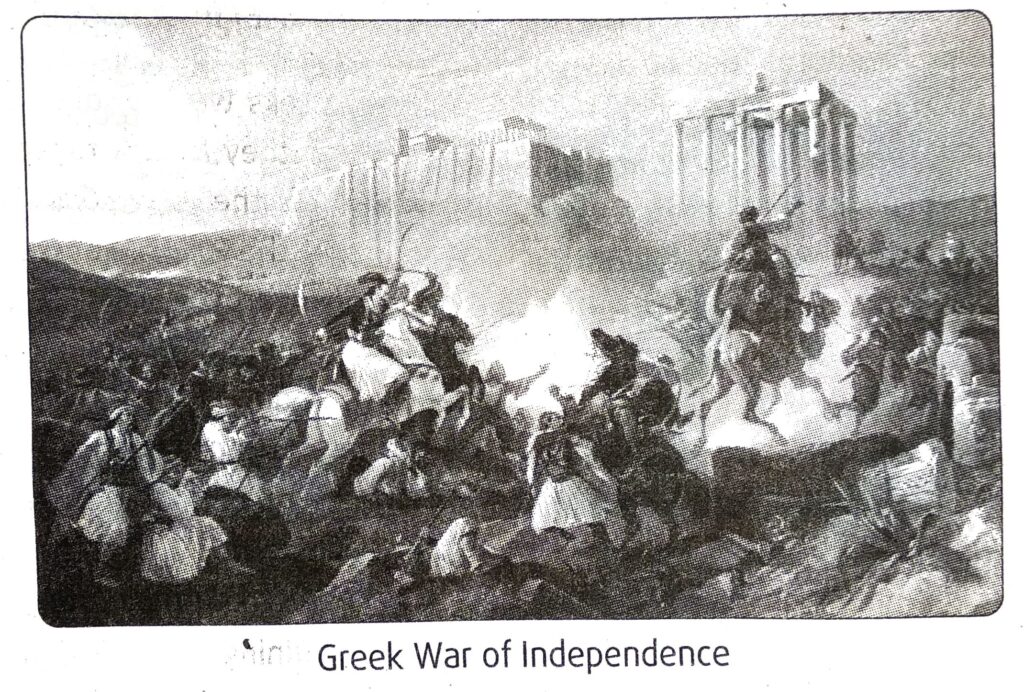
3. What is the significance of the Crimean War ?
Ans. The war declared against Russia by England and France in support of Turkey in 1854 is known as the Crimean War. In this war Russia was defeated. The war is of great significance. [1] The Crimean War laid the foundation of the unification of Italy and Germany. [2] As a consequence of the Crimean War, the internal political situation of Russia was greatly affected. It exposed the weakness of Russia and the people put their demands before this government to introduce reform in the administration. [3] The Crimean War had a great impact upon international politics too. When Russia saw no chance to extend her empire in the Balkan States, she decided to increase her influence in East Asia.
4. Which treaty was concluded after the Crimean War? What were the provisions of the treaty ?
Ans. The Treaty of Paris (1856) was concluded after the Crimean War (1854).
According to the provisions of the treaty[1] England, France and Austria admitted Turkey to the European family of states. [2] The Sultan of Turkey promised to improve the condition of the Christians living in Turkey. [3] Russia and Turkey returned the conquered provinces to each other. [4] Russia promised not to interfere in the internal affairs of Turkey. [5] Russia gave up the right to protect the Christians of Turkey.
5. How would you criticise the ‘Emancipation Statute’ of 1861?
Ans. The Emancipation Statute of 1861 passed by Alexander II, the Czar of Russia, was criticised on the following grounds: [1] The nobles resented the loss of land. The Act also deprived them of the services of the serfs. [2] The edict did not fulfil the expectations of the serfs. The ownership of land was denied to them and was vested in the hands of ‘mirs’. [3] The serfs were subjected to the village mirs instead of the lords. [4] The annual installment of redemption to the money payable government by the serfs in addition to other taxes put a heavy burden on them.
Short Answer (SA) Type Questions
Answer in 2 to 3 sentences
1. Why was the Ottoman empire so named?
Ans. Osman I, a leader of the Turkish tribe in Anatolia founded the Ottoman Empire around 1299. The term ‘Ottoman’ is derived from Osman’s name, which was ‘Uthman’ in Arabic.
2. When and between whom was the First Balkan War fought? Which treaty ended this war ?
Ans. The First Balkan War was fought in 1912. The war was fought between the members of Balkan League (Greece, Bulgaria, Montenegro and Serbia) on one side and Turkey on the other side.
The First Balkan War ended with the Treaty of London (1913).
3. Which countries formed the Balkan League? In which year was the Balkan League formed ?
Ans. The countries which formed the Balkan League were Bulgaria, Serbia, Greece and Montenegro.
The Balkan League was formed in 1912.
4. What is meant by Pan-Slav Movement?
Ans. Pan-Slav was a movement of mid-19th century. It was a political and cultural movement to promote integrity and unity of all the slavic people, living in different parts of Europe.
5. What is Philke Hetaira? at is P
Ans. The Greeks were under the subjugation of Turkey and they fought for independence. The struggle of the Greeks originated in the activities of the Philke Hetaira (a secret society for friendly brotherhood) formed in Odessa (now in Ukraine) in 1814. Its main object was to spread the doctrine of liberty and expel the Turks from Europe. They aimed to revive the old Greek empire of the east. E 210
6. What is ‘Vienna Note’?
Ans. For containing Russian expansion in Turkey the three great powers of Europe-Austria, England and France met at Vienna to take a unanimous decision. In the famous Vienna Note, Russian guardianship over the orthodox Greek Church in Turkey was admitted while Russia was asked to withdraw all other claim on Turkey.
7. What were the provisions of the Treaty of Adrianople?
Ans. Russia defeated Turkey in the Battle of Navarino and forced the Treaty of Adrianople on Turkey in 1829. According to the terms of this treaty Turkey recognised the independence of Greece. Russia got Wallachia and Moldavia. Russia also acquired commercial and political rights besides some territory in Asia.
8. Who is called ‘The Lady with the Lamp’?
Ans. In the Crimean War Britain, France and Turkey fought against Russia. Sidney Herbert, the minister for war asked Florence Nightingale to lead a team of nurses to help the wounded soldiers.
She worked 20 hours a day. At night she walked around the wards of the hospital to make sure that the soldiers were comfortable. She carried a lamp with her, so the soldiers called her ‘The Lady with the Lamp’.
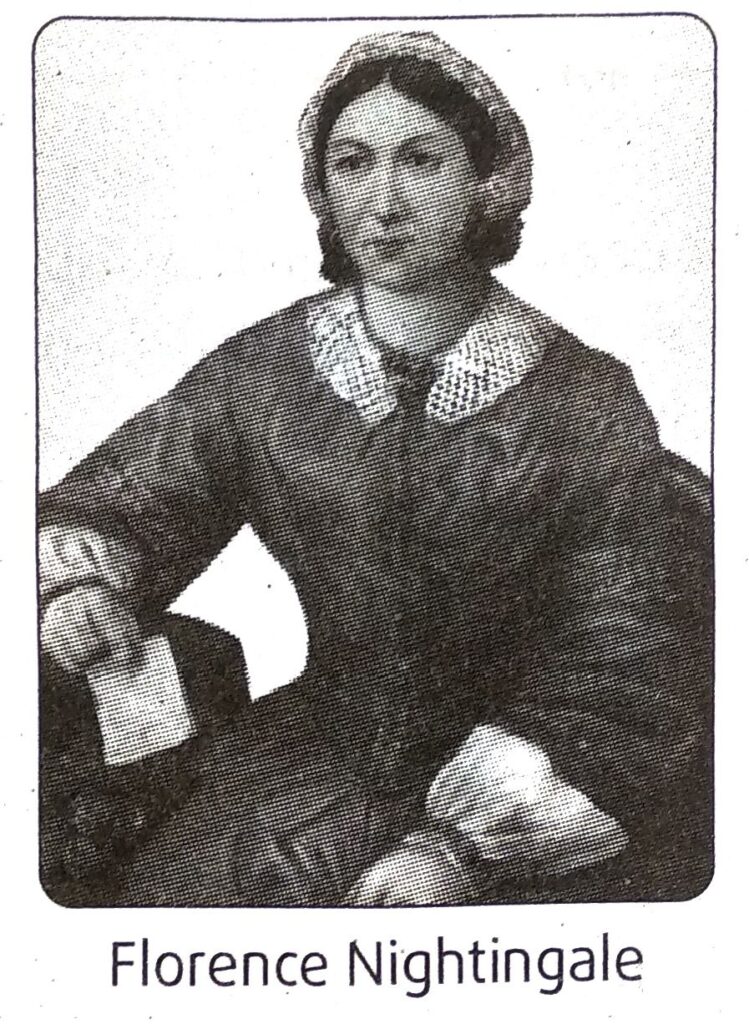
9. Did Czar Alexander II really liberate the serfs ?
Ans. Czar Alexander II passed the ‘Emancipation Statute’ in 1861 which abolished serfdom in Russia and came to be known as ‘Czar the liberator’. However in practice the peasants were not liberated. The ownership of land was denied to them and was vested in the hands of ‘mirs’. The serfs were subjected to the village mirs instead of the lords who exploited them in various ways.
10. In which year and by whom was a commission formed for the abolition of serfdom?
Ans. In 1857 the Czar of Russia, Alexander II, formed a commission for the abolition of sérfdom.
11. Czar Alexander II could not satisfy the people-Give evidence.
Ans. In spite of passing the Emancipation Statute of 1861 several attempts were made on the life of Alexander II and he was killed in the streets of St. Petersburg by a bomb thrown at him by a member of the revolutionary group ‘People’s Will .
Very Short Answer (VSA) Type Questions
Answer in one sentence
1. What is the other name of ‘Balkan’ region ?
Ans. The other name of Balkan region is Near East.
2. Name some nationalities living in the Balkan region.
Ans. Some nationalities living in the Balkan region were Greek, Serb, Romanian, Albanian, Bulgarian etc.
3. In which year and between whom was the Treaty of San Stephano signed?
Ans. The Treaty of San Stephano was signed in 1878 between Russia and Turkey.
4. In which year and by which treaty did Turkey accept the independence of Greece?
Ans. Turkey accepted the independence of Greece by the Treaty of London in 1832.
5. Why was the war between England, France and Russia in 1854 known as the Crimean War?
Ans. The war between England, France and Russia in 1854 was known as the Crimean War because it was fought in Crimea, a peninsula in Southern Russia.
6 . When was the Crimean War fought ?
Ans. The Crimean War was fought during 1854 – 56.
7. Name one Socialist leader of Europe.
Ans. One Socialist leader of Europe was Louis Blanc.
8. Which country is known as the ‘Sick man of Europe’?
Ans. Turkey is known as the ‘Sick man of Europe’.
9. Who was Louis Kossuth?
Ans. Louis Kossuth was a nationalist leader of Hungary during the February Revolution of 1848.
10. Who was known as Czar?
Ans. The emperor or king of Russia was known as Czar.
11 Which treaty ended the Crimean War?
Ans. The Treaty of Paris signed on 30th March, 1856 ended the Crimean War.
12. What is the meaning of the secret society Philke Hetaira ?
Ans. The meaning of the secret society Philke Hetaira is friendly brotherhood.
13 Who is known as the ‘Father of Modern Russia’?
Ans. Czar Peter the Great is known as the Father of Modern Russia.
14 When was the Second Balkan War fought ?
Ans. The Second Balkan War was fought in 1913.
15. Where was the secret society Hetaira Philke founded?
Ans. The secret society Hetaira Philke was founded in Odessa, Greece (now it is in Ukraine).
16. What is the Russian Parliament known as?
Ans. The Russian parliament is known as ‘Duma’.
17. What was Zemstvo?
Ans. Zemstvo was the organ of rural self government in the Russian empire before the Russian revolution.
18. Who were the Kulaks?
Ans. The Kulaks were the well-to-do peasants of Russia who emerged after the emancipation of serfs in the 19th century.
19. What was ‘mir’?
Ans. Mir was village commune or village council in Russia.
20. Between whom was the Crimean War fought ?
Ans. The Crimean War was fought betwen Ottoman Turkey, England, France and Piedmont on one side and Russia on the other.
21. In how many years instalment the emancipated peasants had to pay off their debts to the Russian government?
Ans. In 49 years instalment the emancipated peasants had to pay off their debts to the Russian Government.
Mark True or False
1. The absolute rule of the French monarchs was known as Czardom.
2. The Russian serfs were emancipated in 1721.
3. The Balkan means the hilly areas between the Aegean Sea and the Danube.
4. In the Crimean War, England and France fought against Austria.
5. The treaty which brought an end to the Crimean War was the Treaty of Paris (1856).
6. The Treaty of San Stephano was concluded after the Crimean War.
7. In Russia the serfs were subjected to the village mirs.
8. According to the ‘Emancipation Statute’ of 1871 the Russian serfs were declared free.
9. Greece was conquered by Russia and lost her independence.
10. In the famous Vienna Note Russian Guardianship over the orthodox Greek Church in Turkey was admitted.
11. According to the Emancipation Statute the serfs were to pay back the advance money to the government in 49 instalments.
12. Louis Kossuth was known as ‘Mazzini of Hungary’.
Answers :
1. False, 2. False, 3. True, 4. False, 5. True, 6. False, 7. True, 8. False, 9. False, 10. True, 11. True, 12. True.
Fill in the blanks
1. The Emancipation Statute was passed by _________ (Alexander I/Alexander II/Nicholas I) of Russia.
2. England and France participated directly in the Crimean War in support of _______(Egypt/Greece/Turkey).
3. The Crimean War came to an end with the signing of the Treaty of ________& (Adrianople/ Versailles/Paris).
4. The Balkan means the hilly area between the Aegean sea and the _______ (Danube/ Adriatic/Mediterranean Sea).
5. ________(Greece/Turkey/
6. In 1821, the people of Greece revolted against ________ (Russia/Turkey/France).
7. The Treaty of Adrianople was signed in ______(1829/1830/1840).
8. The Treaty of Prague was signed in _________ (1865/1866/1867).
9. The Greek people, under the __________ (British/ Spanish/Turkish) rule, began their national liberation movement.
Answers :
1. Alexander II
2. Turkey
3. Paris
4. Danube
5. Turkey
6. Turkey
7. 1829
8. 1866
9. Turkish
Choose the best explanation
1. Statement: Czar Alexander II is called the ‘Czar Liberator’.
Explanation (A) : He improved the condition of the workers.
Explanation (B) : He changed the system of production in industries.
Explanation (C) : He abolished serfdom is Russia.
2. Statement: There were some defects in the Emancipation Statute of 1861.
Explanation (A) : The amount of compensation payable to the landlord by the peasant fixed by the Act was much higher than the customary prices of land in the market.
Explanation (B) : The landlords were required to part, with 50% of their land to be given to the liberated serfs.
Explanation (C) : The serfs were to be full fledged citizens of Russia.
3. Statement: Czar Peter the Great is known as the ‘Father of modern Russia’.
Explanation (A) : Under his leadership modernisation of Russia was started.
Explanation (B) : He abolished serfdom.
Explanation (C) : He improved the economic system of Russia.
Answers :
1. Explanation (C)
2. Explanation (A)
3. Explanation (B)
Multiple Choice Question (MCQ)
1. Philke Hetaira was a secret society of –
A. Germany
B. Turkey
C. Italy
D. Greece
Ans. D
2. Nicholas I was the ruler of –
A. Austria
B. Russia
C. Italy
D. Prussia
Ans. B
3. Moldavia and Wallachia was invaded by –
A. Britain
B. Italy
C. Russi
D. Germany
Ans. C
4. Greece was under the subjugation of –
A. Turkey
B. Russia
C. Germany
D. Italy
Ans. A
5. The ‘Sick Man of Europe’ was –
A. France
B. Greece
C. Italy
D. Turkey
Ans. D
6. In the famous Vienna Note Russia was S asked to withdraw her claims in –
A. Egypt
B. Turkey
C. Italy
D. France
Ans. B
7. The secret society associated with the Greek War of Independence was –
A. Hetaira Philka
B. Carbonari
C. Young Italy
D. Zollverein
Ans. A
8. The Crimean War ended with –
A. Treaty of Pressburg
B. Treaty of Paris
C. Treaty of Prague
D. Treaty of Gastein
Ans. B
9. “The Crimean War was the only perfectly useless war that has been waged” was said by –
A. Adam Smith
B. Vincent Smith
C. EH Carr
D. Sir Robert Morier
Ans. D
10. The Kulaks were –
A . Serfs
B . Factory owners
C. Mahajans
D. Well-to-do peasants
Ans. D
11. Who adopted the Czar title first?
A . Alexander II
B. Nicholas I
C. Ivan IV
D. Bakunin
Ans. C
12. The organ of rural self-government in Russia –
A. Duma
B. Zemstvo
C. Parliament
D. Reichstag
Ans. B
13 The Czar remembered for abolition of serfdom –
A . Alexander I
B. Alexander II
C. Alexander III
D. Alexander IV
Ans. B
14. The Czar known as ‘Czar the Liberator’ –
A. Alexander II
B. Alexander I
C Peter the Great
D. Nicholas I
Ans. A
15 Czar Alexander II died on –
A. 2 January, 1890
B. 14 February, 1885
C. 14 March, 1883
D. 13 March, 1881
Ans. D
16. Czar Alexander II was assassinated by –
A. Black Hand
B. General Will
C. People’s Will
D. Carbonari
Ans. C
17. The First Balkan War was fought in the year –
A. 1911
B. 1912
C. 1913
D. 1914
Ans. B
18. Who ascended the throne after Alexander III ?
A. Nicholas I
B. Ivan IV
C. Alexander IV
D. Nicholas II
Ans. D
TOPIC – G
Miscellaneous
Explanatory Answer (EA) Type Questions
Answer in 12 to 15 sentences
1. What were the similar and dissimilar traits between the July Revolution of 1830 and the February Revolution of of 1848 ?
Ans. Similar traits between the July Revolution of 1830 and the February Revolution of 1848: [1] Both the July and February Revolution originated in France. [2] The impact of both the revolutions was felt all over Europe-Italy, Austria, Germany, Switzerland and England and there were revolutionary uprisings. [3] There was demand for abolition of monarchy during both the revolutions. [4] Both the revolutions witnessed lack of effective leadership and strong emergence of liberal forces.
Dissimilar traits between the July Revolution of 1830 and the February Revolution of 1848: [1] The Revolution of 1830 broke out as a protest against the reactionary policies of Charles X, the ruler of France. The demand of the liberals was a constitutional government. On the other hand the revolution of 1848 was purely a Republican movement influenced by socialist ideas. [2] The July Revolution was peaceful and democratic in character. But the February Revolution was violent and nationalist in character. [3] In the July Revolution of 1830, the people who participated belonged to the middle class whereas in the 1848 Revolution, to socialism participated.
2. Was the Crimean war justified ?
Ans. Declaration of war: The war declared against Russia by England and France in support of Turkey in 1854 is known as the Crimean War. It was an important event in the history of Europe.
View of Robert Morier: Many modern politicians and historians have criticised the nature of this war. They have regarded the Crimean War as a useless modern war of Europe. Robert Morier writes. “The Crimean War was the only perfectly useless war that has been waged.”
Useless War: [1] The Crimean War could not give a permanent solution to the Eastern Question. The war ended with the Treaty of Paris. The provisions of this treaty could not remain permanent. According to the Treaty of Paris, the Sultan of Turkey was supposed to improve the condition of the Christian population living in Turkey. But the Sultan never carried out his promise which he had given at Paris for improving the condition of the Christian population living in Turkey. [2] The aim of the war was to weaken Russia forever. In the Treaty of Paris she was insulted and several restrictions were imposed upon Russia. Russia could never forget her humiliation. [3] England and France could not get any advantage from this war. The Crimean War proved disastrous for the allies.
Therefore, it may be said that the Crimean War was quite useless and it might have been avoided.
Follow on Facebook page – Click Here
Google News join in – Click Here
Read More Asia News – Click Here
Read More Sports News – Click Here
Read More Crypto News – Click Here